YOUNG SCIENTISTS' FORUM
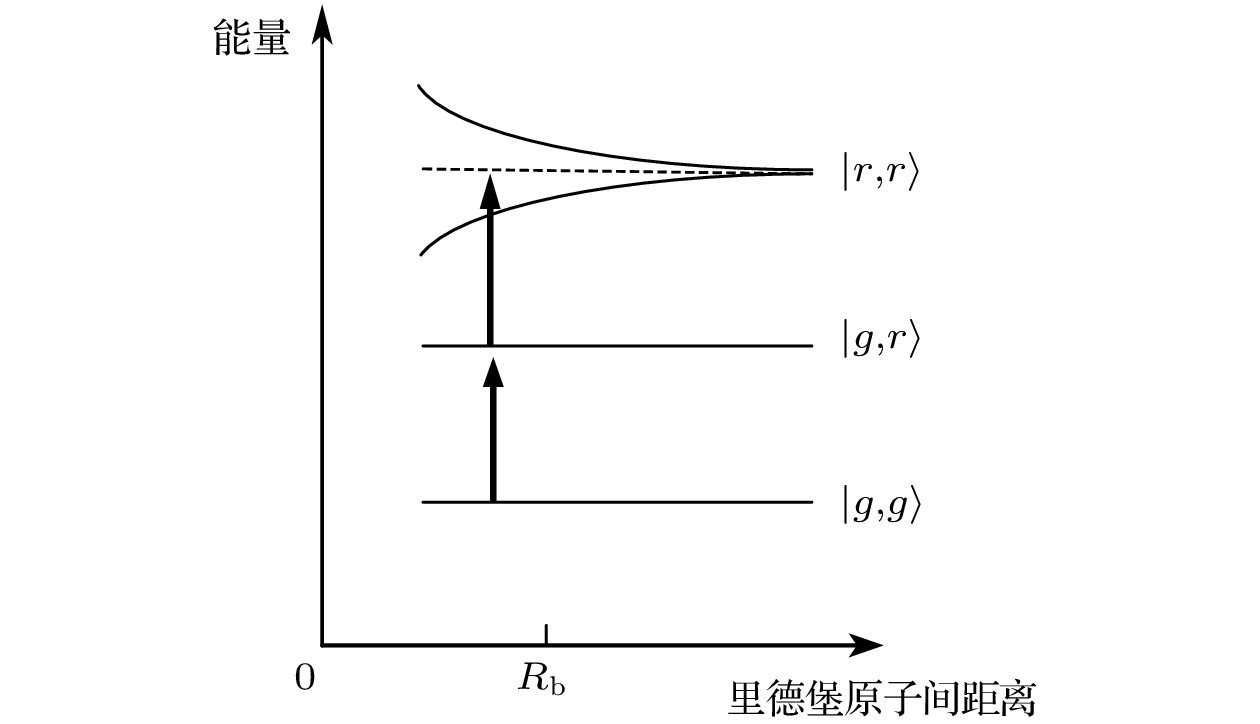
YOUNG SCIENTISTS' FORUM
2020, 69 (18): 180301.
doi:10.7498/aps.69.20200649
Abstract +
The interaction of many-body quantum system is a critical problem to be solved in the field of quantum information science. Rydberg atoms have large dipole moment, enabling them to interact with others in a long range, thereby offering us a powerful tool for studying many-body quantum physics. Meanwhile, atoms in the ground state are stable, which makes it easy to manipulate them. Therefore, Rydberg-atom many-body system is an ideal platform for studying the interaction of many-body quantum system. Studies of Rydberg-atom many-body system may contribute to understanding the properties of many-body system and putting the interaction of many-body quantum system into practical applications. In this review, we introduce some studies of properties of interaction of Rydberg-atom many-body system, including the Rydberg excitation blockade, the variation of Rabi frequencies of the many-body system and special spatial distribution of Rydberg atoms in a many-body system. Firstly, the Rydberg excitation blockade, the most important property in the Rydberg-atom many-body system, indicates that atoms’ excitation will be suppressed in a certain range around one Rydberg excitation because the interaction between the Rydberg excitation and atoms leads the energy level to shift so that atoms cannot be excited by the same pulse. Secondly, there is a collective Rabi frequency in the system, which is proportional to the square of the number of atoms in the suppressed area. And additionally, because of the Rydberg blockade effect, Rydberg excitations in the ensemble cannot be at casual positions but a regular distribution is formed. Besides the studies of properties, several researches on the applications of interaction of Rydberg-atom many-body system are introduced, including single-photon source, quantum storage, single-atom imaging, quantum simulation, etc. These applications contribute to the development of quantum community and quantum computing, which may bring us a quantum-technology time. Finally, we discuss the future development of Rydberg-atom many-body system and its further applications. Further development includes the development of many-body system with a larger number of atoms, the development of many-body system of atoms with more than one electron, and some other specific subjects based on many-system, such as Rydberg dimer and topological phase. Also some promising applications such as in studying optimization problem by quantum annealing, may become true.
SPECIAL TOPIC-Nonlinear optics and devices of low-dimensional materials
SPECIAL TOPIC—Nonlinear optics and devices of low-dimensional materials
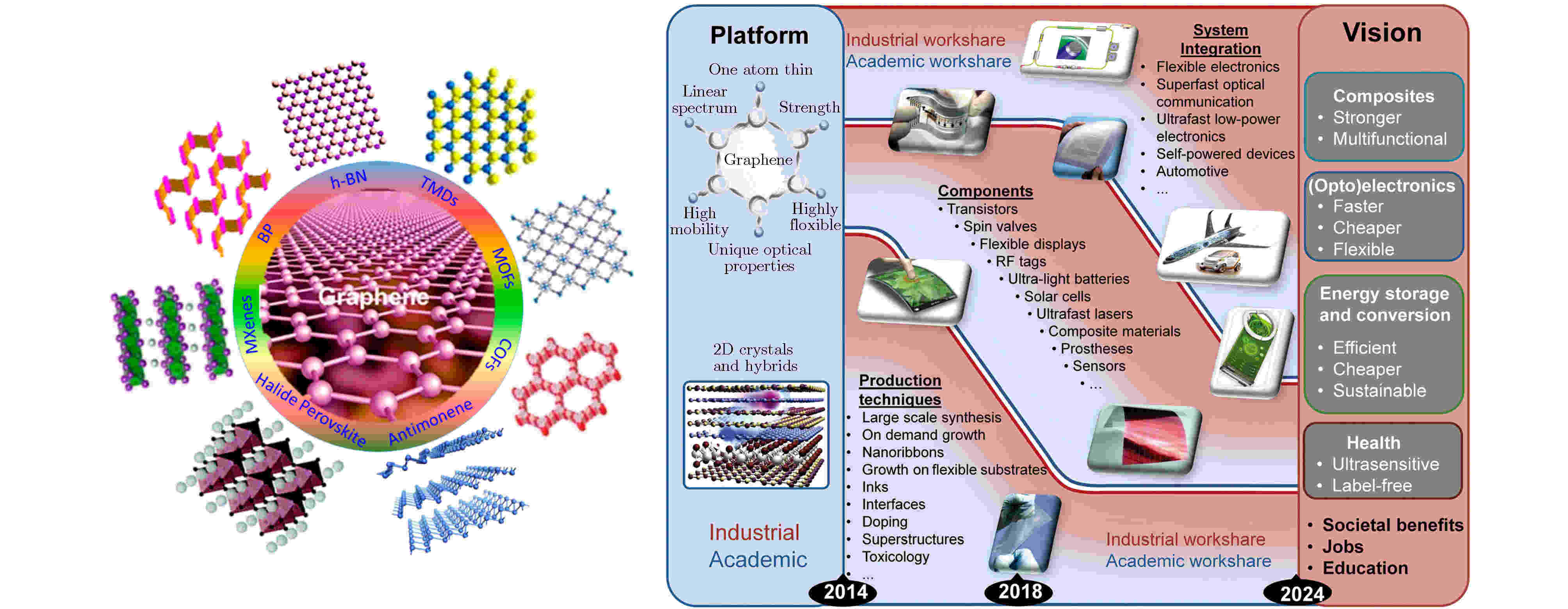
2020, 69 (18): 184201.
doi:10.7498/aps.69.20200313
Abstract +
To achieve simultaneous protection against both pulsed and continuous wave (CW) or quasi-CW lasers, significant research effort has been devoted to the state-of-the-art optical limiting (OL) materials and processes in an attempt to achieve some measures of protection against such laser beams in the past decades. Two-dimensional (2D) nanomaterials with a lot of unique properties, including graphene, transition metal dichalcogenides, black phosphorus and others, have aroused the extensive research interest of many researchers. In this review paper, we describe systematically the OL mechanisms and the recent achievements in the 2D nanomaterials and their organic/polymeric derivatives for laser protection. In an effort to sustain the advantage of 2D nanomaterials, one can not only introduce the functional molecules or polymers to blend with them to form a complex multi-phase material system, but also embed the soluble 2D nanosheets covalently functionalized with organic/polymeric materials in a polymer host to form host-guest composite materials that are expected to improve the OL performance of the whole system. All in all, an optimized complex multi-component nanomaterial system enormously enhances the performance and applicability of OL devices. In addition, the fundamental studies of the photophysical and photonic properties of 2D nanomaterials and their derivatives in various solid hosts are of significance for modifying the nanomaterials at a molecular level.
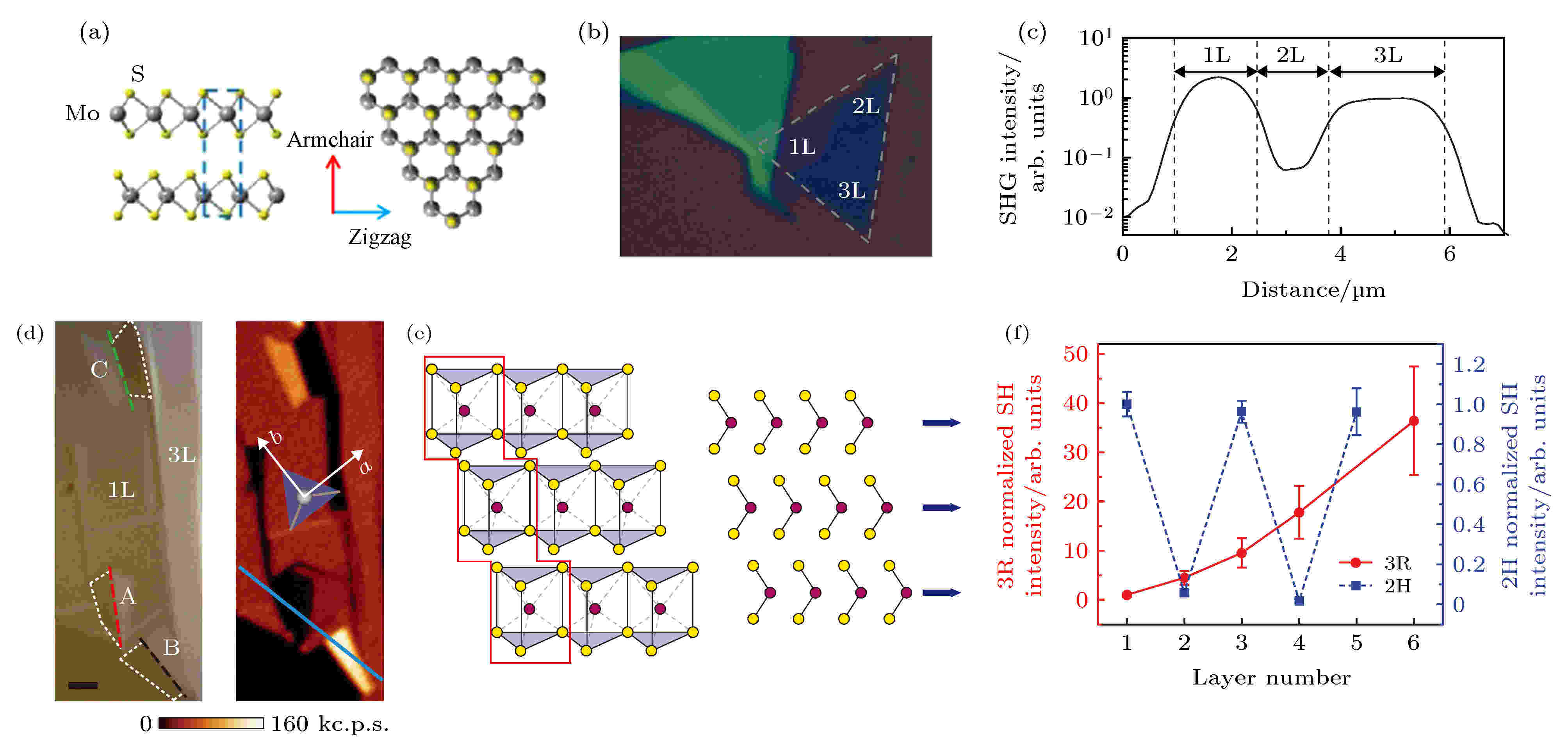
2020, 69 (18): 184210.
doi:10.7498/aps.69.20200452
Abstract +
Two-dimensionl (2D) layered transition metal dichalcogenides (TMDCs) have received great attention in integrated on-chip photonic and photoelectric applications due to their unique physical properties including indirect-to-direct optical bandgap transition, broad bandgap from visible band to near-infrared band, as well as their excellent optoelectric properties derived from the 2D confinement. Recently, with the in-depth study of their fundament nonlinear optical properties, these 2D layered TMDCs have displayed significant potential applications in nonlinear optical devices. In this review, we focus on recent research progress of second harmonic generation (SHG) studies of TMDCs. Firstly, we briefly introduce the basic theory of nonlinear optics (mainly about SHG). Secondly, the several intrinsic SHG relative properties in TMDCs including layer dependence, polarization dependence, exciton resonance effect, valley selection rule are discussed. Thirdly, the latest SHG modulation and enhancement studies are presented, where the electric field, strain, plasmonic structure and micro-cavity enhancement are covered. Finally, we will summarize and give a perspective of possible research direction in the future. We believe that a more in-depth understanding of the SHG process in 2D layered TMDCs as well as the material structure and modulation effects paves the way for further developing the ultra-thin, multifunctional 2D nonlinear optical devices.
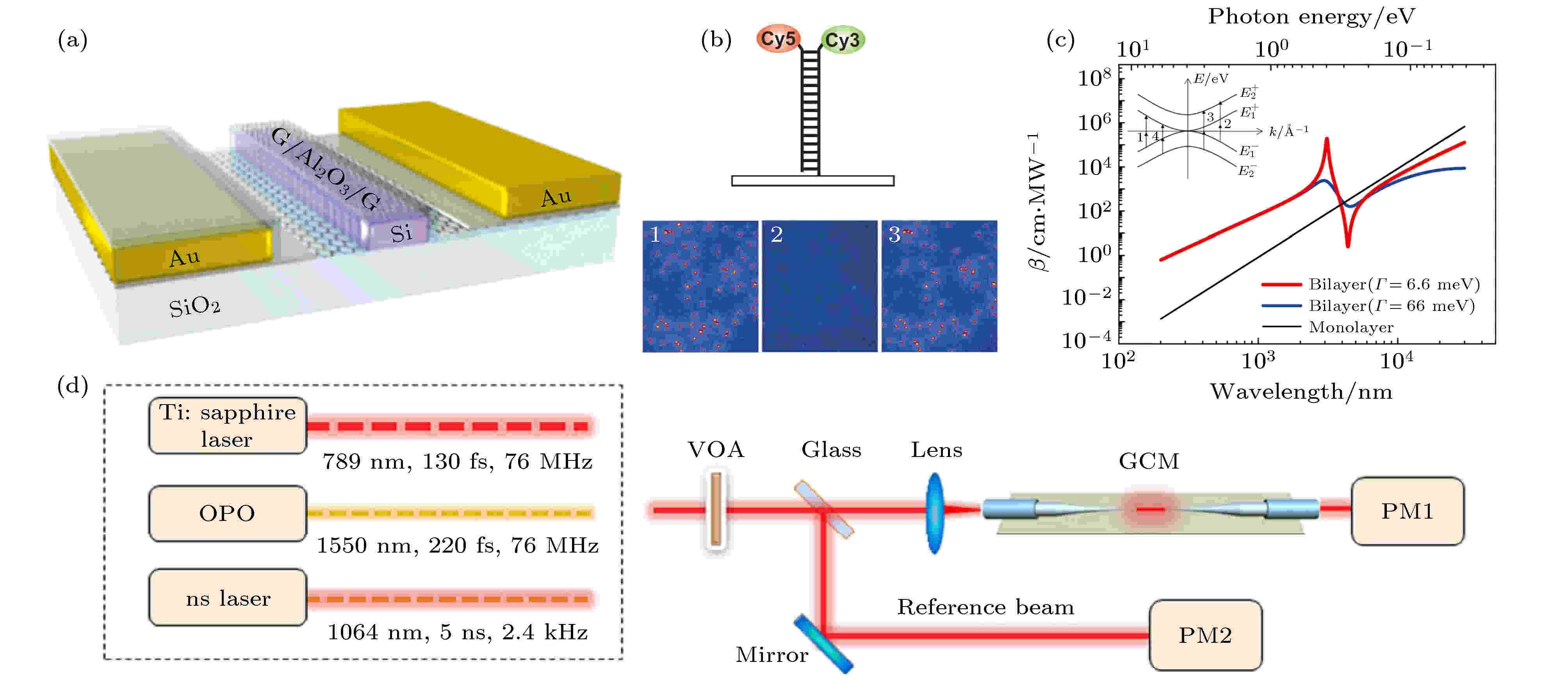
2020, 69 (18): 184211.
doi:10.7498/aps.69.20200206
Abstract +
Since the first ruby laser was invented, researchers have focused their attention on how to achieve a strong laser light source, which cannot be produced by the ordinary light sources. Since then, the rich and colorful characteristics of nonlinear optical materials have been discovered, such as the saturation absorption, reverse saturation absorption and nonlinear refraction. They are applied to optoelectronic devices, optical switching devices and optical communication. At the same time, with the increase of the requirements for device integration performance in industrial production, ordinary three-dimensional devices are difficult to meet the production requirements, and the advent of low-dimensional semiconductor devices effectively solves this problem. Therefore, the combination of nonlinear optics and low-dimensional semiconductor materials is a general trend. The emergence of quantum dots, quantum wire lasers, and amplifiers confirms this. In this paper, we summarize the frontier work on nonlinear optics by selecting several special low-dimensional structures and several materials, providing some references for future research. However, due to the fact that the instability and low filling ratio of low-dimensional materials remain to be improved, further relevant research is still required.
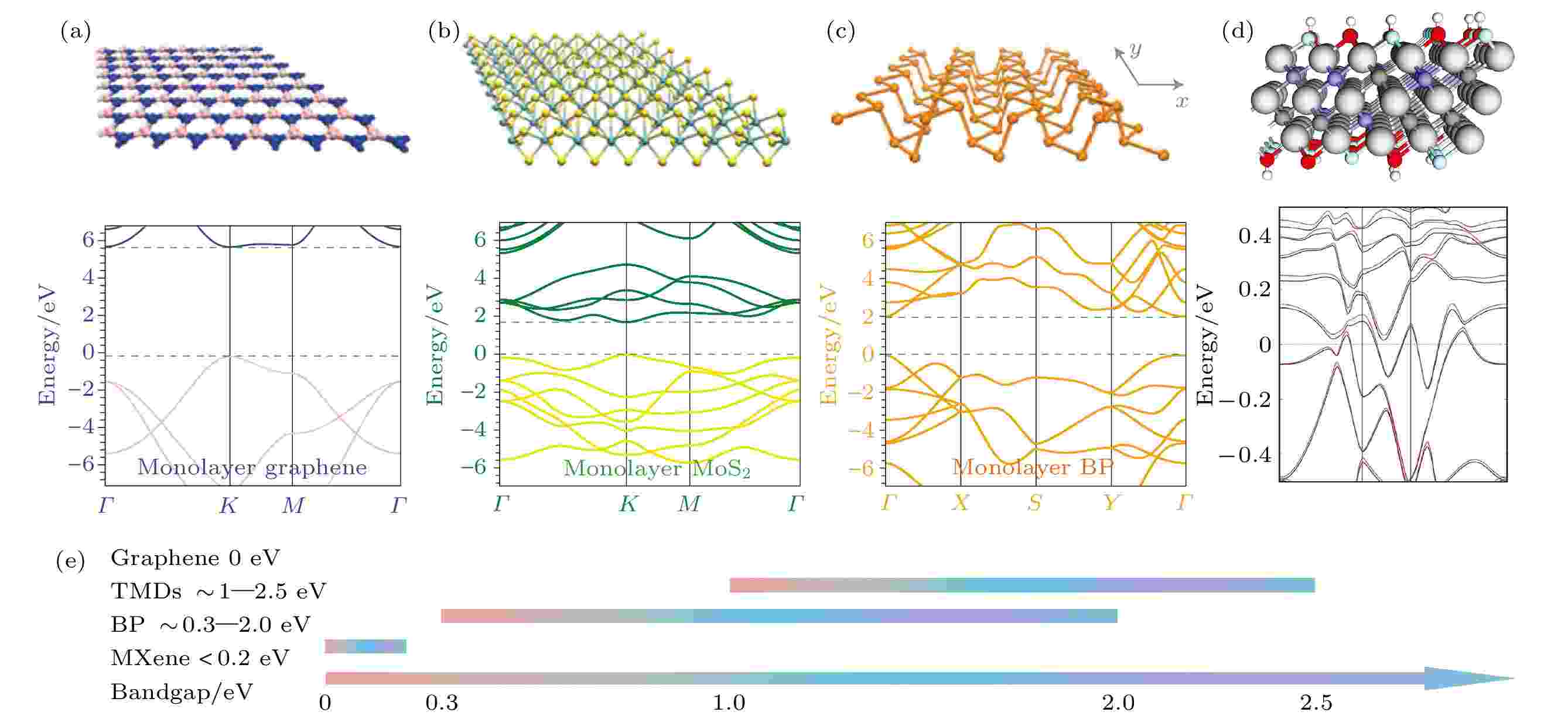
2020, 69 (18): 184216.
doi:10.7498/aps.69.20200654
Abstract +
The leap in communication technology in recent years has brought new challenges to the compactness, modulation speed, working bandwidth and control efficiency of modulation equipment. The discovery of graphene has led the two-dimensional materials to develop rapidly, and a series of new materials have continuously emerged, such as MXene, black phosphorus, transition metal sulfides, etc. These new two-dimensional materials have excellent nonlinear optical effects, strong light-matter interaction, and ultra-wide working bandwidth. Using their thermo-optic effect, nonlinear effect and the combination with optical structure, the needs of ultra-fast modulation in optical communication can be met. Compact, ultra-fast, and ultra-wide will become the tags for all-optical modulation of two-dimensional materials in the future. This article focuses on all-optical devices based on thermo-optical effects and non-linear effects of two-dimensional materials, and introduces fiber-type Mach-Zehnder interferometer structures, Michelson interferometer structures, polarization interferometer structures, and micro-ring structures. In this paper, the development status of all-optical devices is discussed from the perspectives of response time, loss, driving energy, extinction ratio, and modulation depth. Finally, we review the latest developments, analyze the challenges and opportunities faced by all-optical devices, and propose that all-optical devices should be developed in the direction of ring resonators and finding better new two-dimensional materials. We believe that all-optical devices will maintain high-speed development, acting as a cornerstone to promote the progress of all-optical systems.

2020, 69 (18): 188101.
doi:10.7498/aps.69.20200472
Abstract +
The two-dimensional (2D) nanomaterial saturable absorber represented by graphene is widely used in ultrafast fiber lasers due to its unique nonlinear optical properties. In this paper, we summarize the research and development of 2D nanomaterials as saturable absorbers in mid-infrared ultrafast mode-locked fiber lasers in recent years, and introduce the atomic structure and nonlinear optical characteristics of 2D nanomaterials, and saturable absorber device integration methods. The laser performance parameters such as center wavelength, repetition frequency and average output power of the laser are discussed, and the femtosecond fiber laser based on black phosphorus saturable absorber in the middle infrared band is highlighted. Finally, the developments and challenges of 2D materials in mid-infrared pulsed fiber laser are also addressed.

2020, 69 (18): 188102.
doi:10.7498/aps.69.20201235
Abstract +
As the substance carrier of nonlinear optical phenomenon, saturable absorber is an essential material for generating the ultrafast pulse laser. The saturable absorbers based on graphene, transition metal sulfides, topological insulators, black phosphorus and other two-dimensional (2D) materials exhibit different optical advantages. However, limitations of those single 2D materials as saturable absorbers exist. The nanomaterial heterojunction structure can combine the advantages of different 2D materials to achieve optical complementarity, and it also provides new ideas for generating the ultrafast laser with ultrashort pulse duration and high peak power. Here in this paper, the preparation methods, band alignment and the electronic transition mechanism of heterojunction saturable absorbers are summarized, and the recent research progress of ultrafast lasers based on 2D nano-heterostructures are also reviewed, including the wavelength, pulse width, repetition frequency and pulse energy. Therefore, 2D nano-heterostructure exhibits great potential applications in future optical modulator and optical switch.
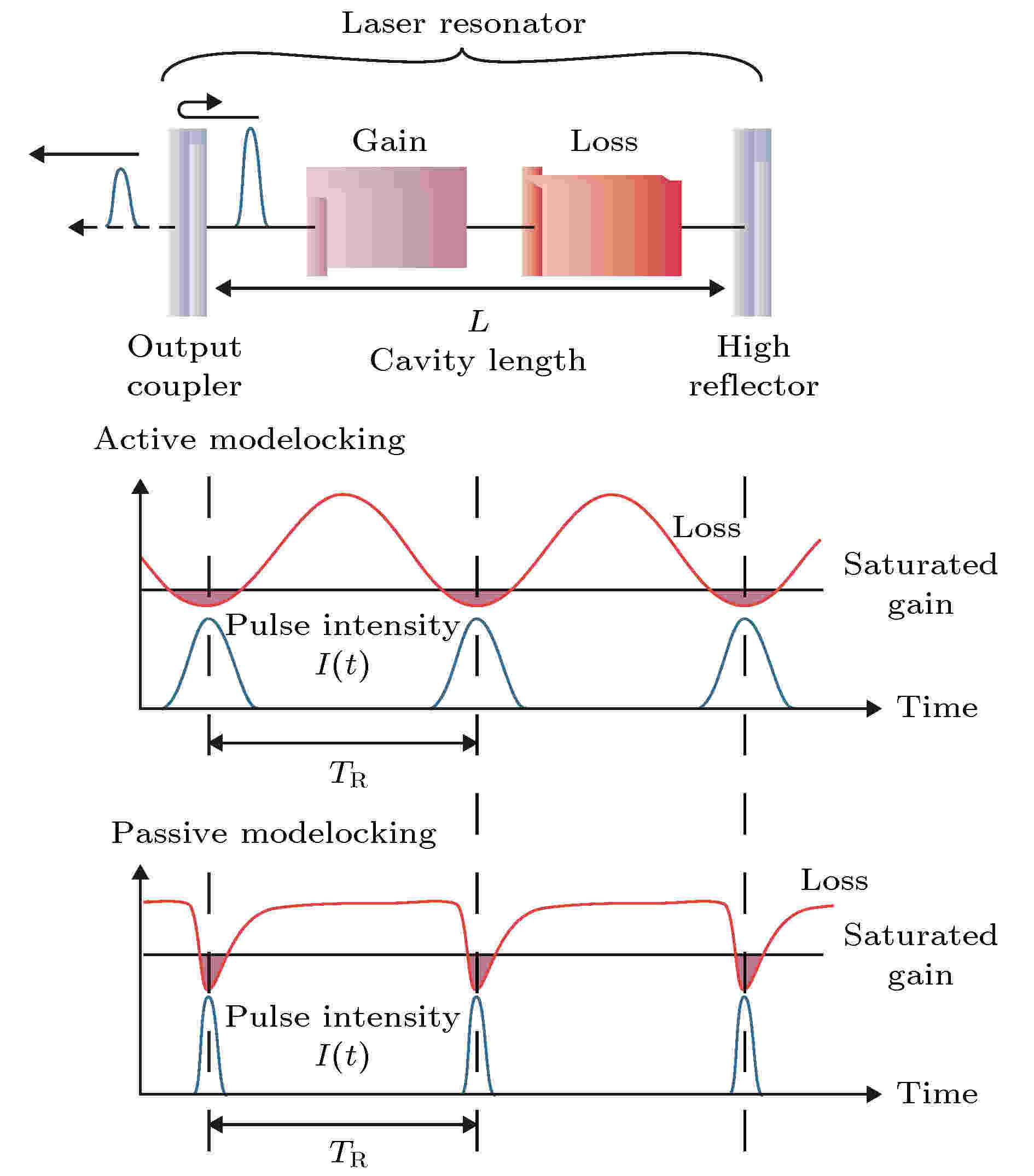
2020, 69 (18): 189101.
doi:10.7498/aps.69.20200456
Abstract +
Nonlinear optical (NLO) effects are ubiquitous in the interaction of light with different materials. However, the NLO responses of most materials are inherently weak due to the small NLO susceptibility and the limited interaction length with the incident light. In plasmonic nanostructures the optical field is confined near the surface of the structures, so that the electromagnetic field is greatly enhanced in a localized fashion by spectral resonance. This effect results in the enhancement of light-matter interaction and NLO response of the material. Ultrafast pulse lasers have been widely used in optical communication, precise measurement, biomedicine, military laser weapons and other important fields due to their excellent performances. Although commercial lasers become very matured, they can achieve ultra-high peak power and ultra-short pulse width and ultra-high repetition rate, but the ultra-fast pulses in the mid-to-far infrared band are seldom studied, so finding a saturable absorber material with excellent performance is of great significance for developing the pulsed lasers. In this paper, we review the recent research progress of the applications of exiton nanostructure in ultrafast optical switches and pulse lasers based on noble metal and non-noble metals. The metallic system mainly refers to gold and silver nanoparticles. For non-noble metals, we mainly introduce our researches of chalcogenide semiconductor, heavily doped oxide and titanium nitride. A variety of wide bandgap semiconductors can exhibit metal-like properties through doping. Since doping can form free carriers, when their size is reduced to a nanometer scale, they will show the characteristics of local surface plasmon resonance, thus realizing ultra-fast nonlinear optical response, and the concentration of doped carriers cannot reach the level of metal carriers, thus being able to effectively reduce the inter-band loss caused by excessively high carriers. Through pump probe detection and Z-scan testing, we found that these plasmonic nanostructures exhibit ultrafast NLO response in tunable resonance bandwidth, which has been utilized as a working material for developing the optical switch to generate the pulsed laser with duration down to a femtosecond range. These results take on their potential applications in ultrafast photonics. Finally, we make a comparison of the pros and cons among different plasmonic materials and present a perspective of the future development.
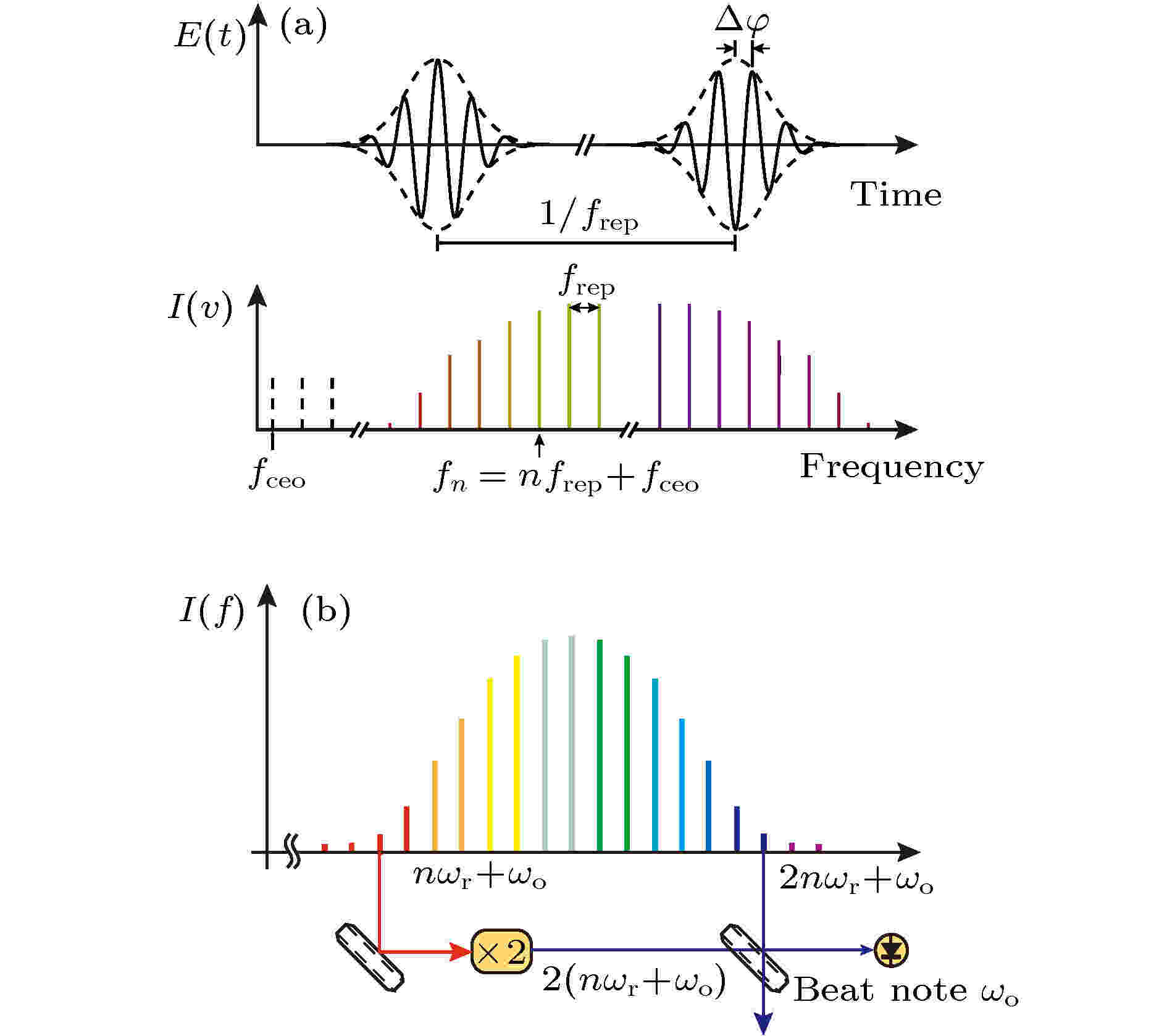
2020, 69 (18): 189501.
doi:10.7498/aps.69.20200399
Abstract +
Optical frequency comb consists of a series of equally spaced and highly stable frequency lines. Due to the advantages of the ultra-high frequency stability and ultra-low phase noise, the optical frequency combs have important applications in high precision spectroscopy, imaging, communications, etc. In the terahertz frequency range, semiconductor-based electrically pumped terahertz quantum cascade lasers have the characteristics of high output power and wide frequency coverage, and are the ideal candidates for generating terahertz optical frequency combs. In this article, we first briefly introduce the research progress of the optical frequency comb in the communication and the mid-infrared bands. Then we mainly review the research progress of the optical frequency combs based on the terahertz semiconductor quantum cascade laser (QCL) operating in free-running, active frequency stabilization and passive frequency stabilization modes. In free running mode, the terahertz QCL frequency comb is mainly limited by the large group velocity dispersion which results in a small comb bandwidth. Therefore, the dispersion compensation is one of the important methods to stabilize the optical frequency comb and broaden the spectral bandwidth. At present, the active frequency stabilization mode is a relatively matured method to realize the optical frequency combs in terahertz QCLs. In this article, we also detail the methods and applications of terahertz QCL dual-comb operations, including on-chip dual-comb and dual-comb spectroscopy. Compared with the Fourier transform infrared spectroscopy and time domain spectroscopy, the terahertz dual-comb spectroscopy has advantages in fast data acquisition (real-time) and high spectral resolution. The emergence of the dual-comb technique not only verifies the concept of optical frequency combs, but also further promotes the applications of frequency combs.

2020, 69 (18): 184205.
doi:10.7498/aps.69.20200337
Abstract +
As a new two-dimensional material, bismuth nanosheet is an effective modulator for realizing a mid-infrared pulsed laser, which benefits from its suitable band gap, higher carrier mobility and better room temperature stability, as well as its excellent electrical and optical properties. The mid-infrared single-crystal fiber is a preferable gain medium for high-power laser because of its advantages of both crystal and fiber. In this paper, a bismuth nanosheet saturable absorber is successfully prepared by the ultrasonic method and used for the first time in a diode-pumped Er:CaF2single-crystal fiber mid-infrared passivelyQ-switching pulsed laser. A compact concave planar linear resonator is designed to study theQ-switching Er:CaF2single-crystal fiber laser with bismuth nanosheets serving as saturable absorbers. The pump source is a fiber-coupled semiconductor laser with a core diameter of 105 μm, a numerical aperture of 0.22, and a central emission wavelength of 976 nm. The pump light is focused onto the front end of the gain medium through a coupled collimating system with a coupling ratio of 1∶2. The gain medium is a 4 at.% Er3+:CaF2single-crystal fiber grown by the temperature gradient method, and this fiber has two polished but not coated ends, a diameter of 1.9 mm, and a length of 10 mm. To reduce the thermal effect, the single-crystal fiber is tightly wrapped with indium foil and mounted on a copper block with a constant temperature of 12 ℃. The input mirror has a high reflection coating at 2.7–2.95 μm and an antireflection coating at 974 nm, with a curvature radius of 100 mm. A group of partially transmitting plane mirrors are used as output couplers, respectively, with transmittances of 1%, 3%, and 5% at 2.7–2.95 μm. The total length of the resonant cavity is 26 mm. By inserting the bismuth nanosheet into the resonator and carefully adjusting its position and angle, a stable mid-infraredQ-switching laser is obtained. At the absorbed pump power of 1.52 W, a pulsed laser with an average output power of 190 mW is obtained for an output mirror with a transmittance of 3%. The shortest pulse width is 607 ns, the repetition frequency is 58.51 kHz, and the corresponding single pulse energy and peak power are 3.25 μJ and 5.35 W, respectively.
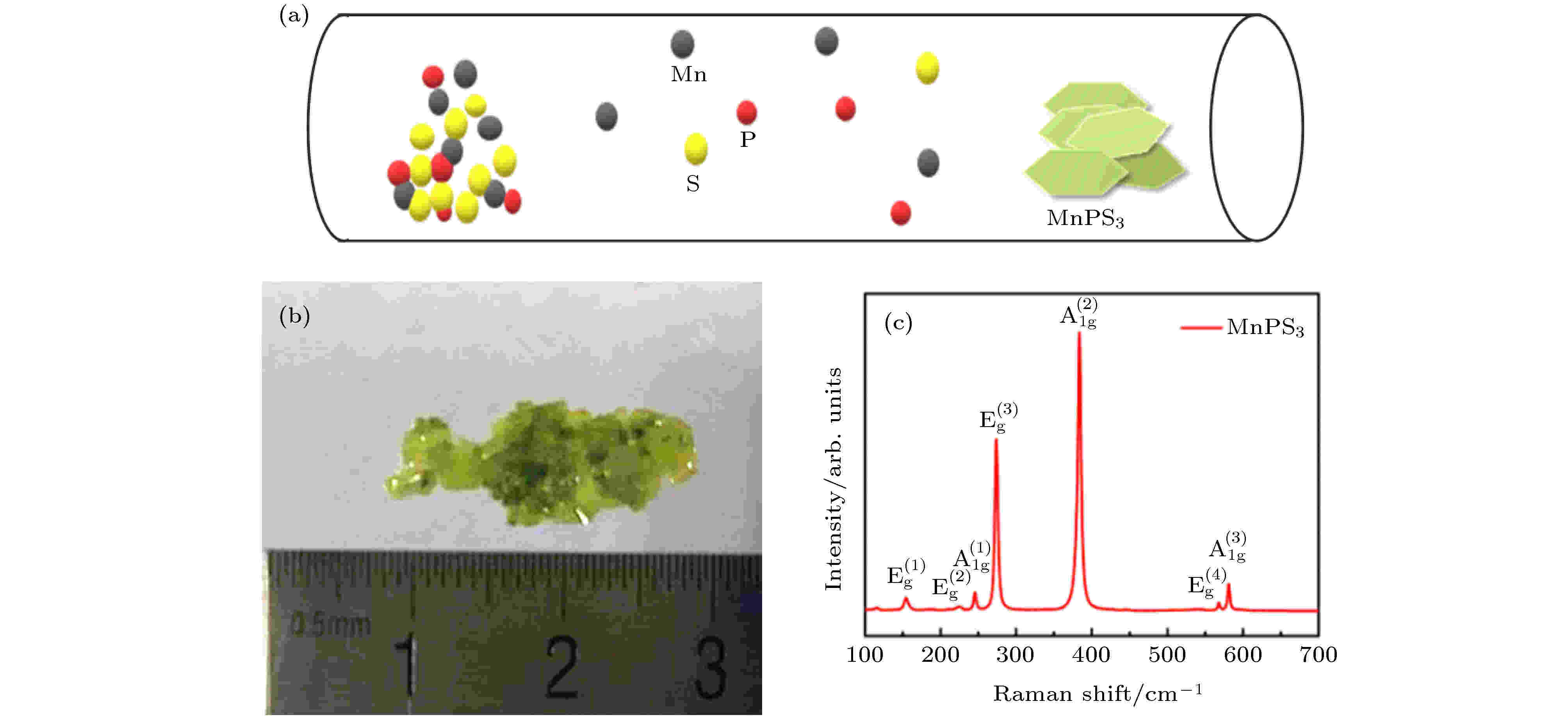
COVER ARTICLE
2020, 69 (18): 184208.
doi:10.7498/aps.69.20200342
Abstract +
As a member of the metal phosphorus trichalcogenide family, MPS3is widely used in nonlinear optics and devices, which can be regarded as a significant benefit for the excellent photonic and optoelectronic properties. In this work, the MnPS3nanosheet is prepared by the chemical vapor transport method and the MnPS3saturable absorber is demonstrated by modifying mechanical exfoliation. To the best of our knowledge, the dual-wavelength self-starting mode-locking erbium-doped fiber laser with MnPS3saturable absorber is demonstrated for the first time. The dual wavelength mode-locked laser with a pulse repetition rate of 5.102 MHz at 1565.19 nm and 1565.63 nm is proposed. Its maximum output power at the dual-wavelength is 27.2 MW. The mode-locked laser can self-start and stably run for more than 280 h.
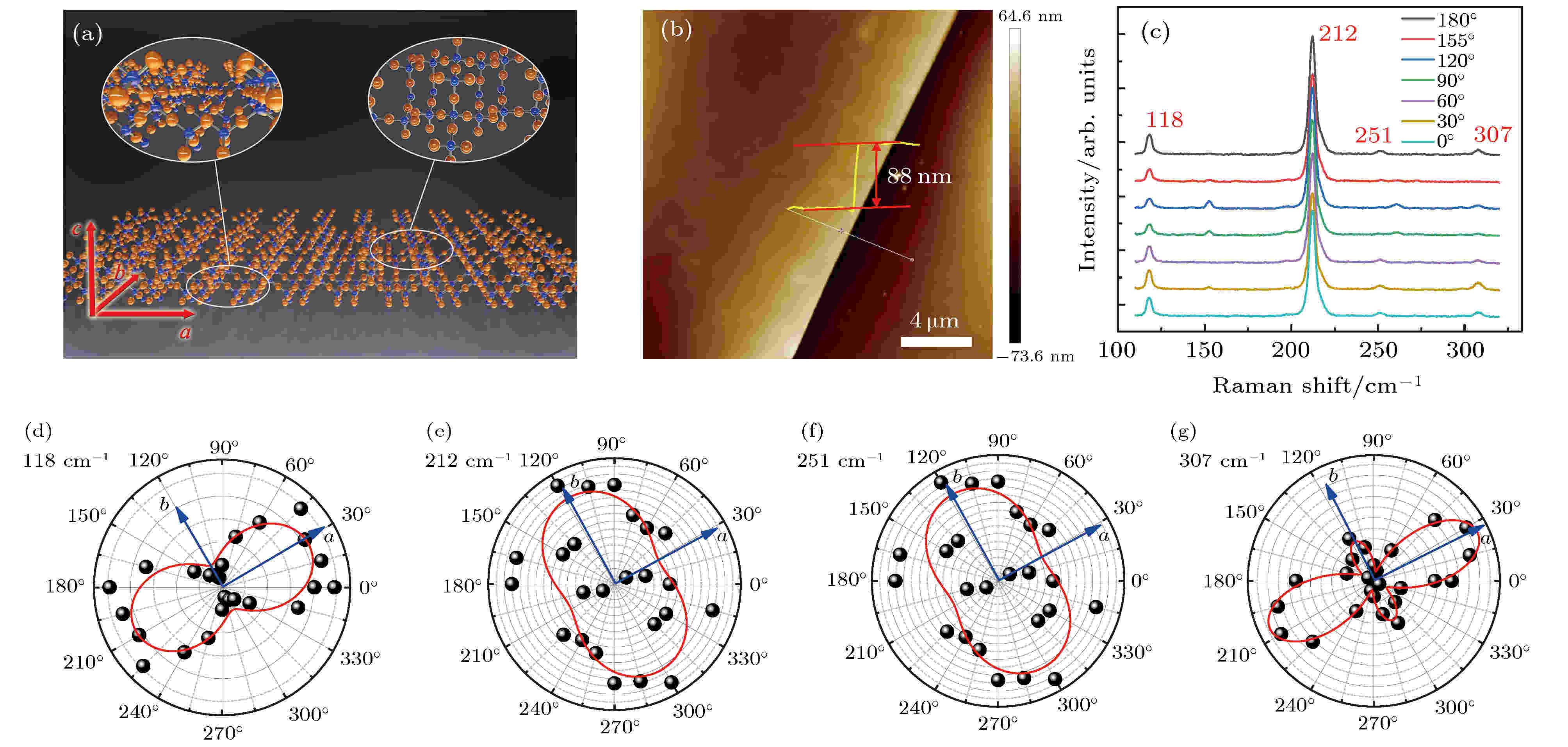
2020, 69 (18): 184212.
doi:10.7498/aps.69.20200443
Abstract +
Germanium diselenide (GeSe2), a layered IV-VI semiconductor, has an in-plane anisotropic structure and a wide band gap, exhibiting unique optical, electrical, and thermal properties. In this paper, polarization axis Raman spectrum and linear absorption spectrum are used to characterize the crystal axis orientation and energy band characteristics of GeSe2flake, respectively. Based on the results, a micro-domain I scan system is used to study the optical nonlinear absorption mechanism of GeSe2near the resonance band. The results show that the nonlinear absorption mechanism in GeSe2is a superposition of saturation absorption and excited state absorption, and is strongly dependent on the polarization and wavelength of incident light. Under near-resonance excitation (450 nm), the excited state absorption is more greatly dependent on polarization. With different polarizations of incident light, the modulation depth can be changed from 4.6% to 9.9%; for non-resonant excitation (400 nm), the modulation depth only changes from 7.0% to 9.7%. At the same time, compared with saturation absorption, the polarization-dependent excited state absorption is greatly affected by the distance away from the resonance excitation wavelength.
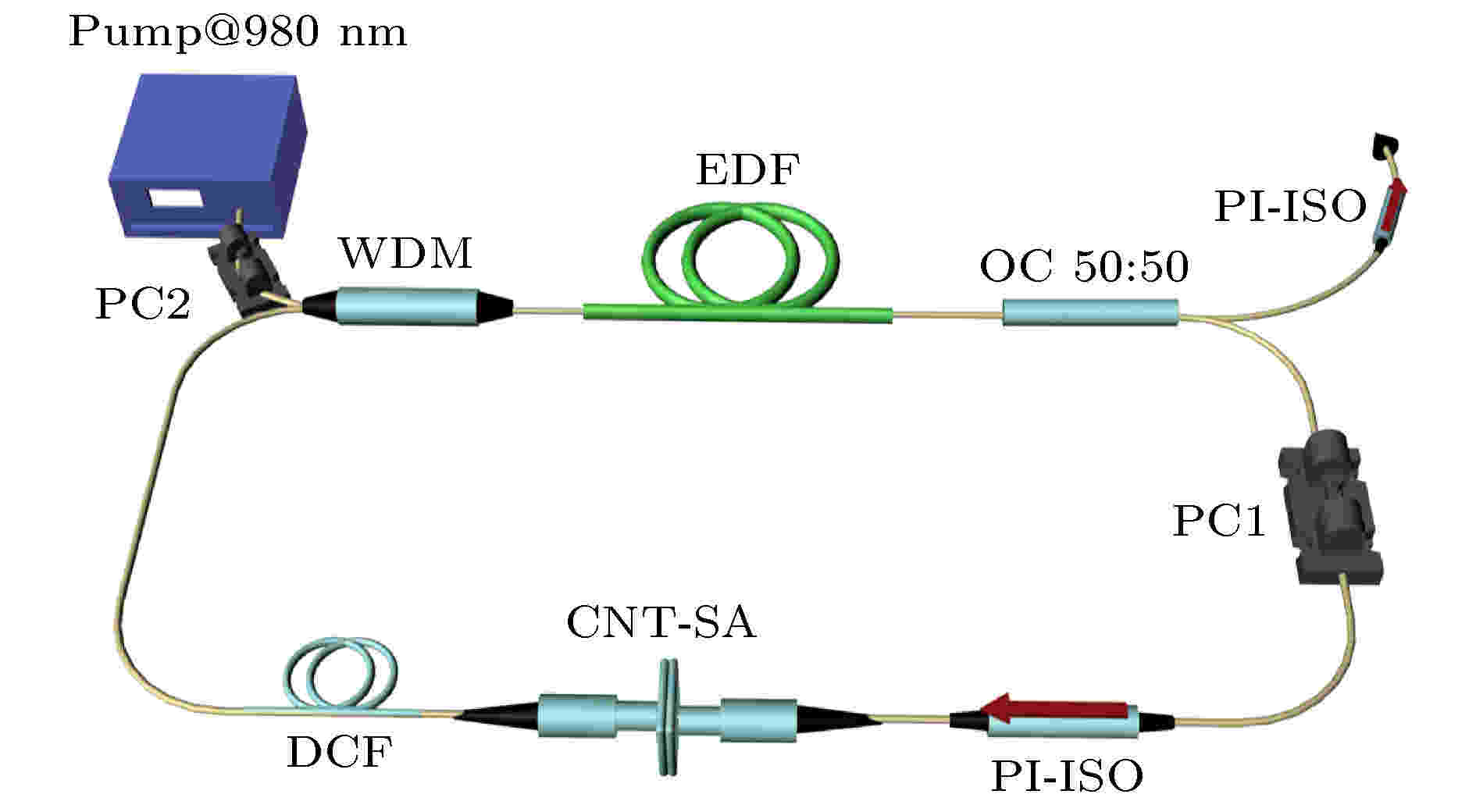
2020, 69 (18): 184218.
doi:10.7498/aps.69.20201305
Abstract +
In this paper, a dissipative soliton mode-locked fiber laser is established based on carbon nanotube in order to study the polarization dynamics of dissipative soliton by using a commercial polarimeter. Under the pump power of 160 mW, stable dissipatives soliton are observed to have a limited cycle polarization trajectory shown on Poincare sphere, indicating the periodic modulation of anisotropy in cavity. The stable dissipative soliton possesses a high signal noise ratio of 57.7 dB at fundamental frequency. Moreover, the fast oscillation of state of polarization leads to a lower degree of polarization (DOP). In addition, the polarization controllers are employed to compensate for the birefringence in the cavity to adjust the ratio between cavity length and birefringence length. As a result, we can observe the polarization evolving from the polarization locked attractor to the limited cycle attractor by adjusting polarization controllers. It is noted that this dynamic polarization trajectory can be manually controlled. By comparing polarization attractor with DOP, it is clear that the size of trajectory shown on Poincare sphere is inversely proportional to DOP. We expect our work to be conducible to studying the physics in lasers and creating a new type of polarization tunable laser.
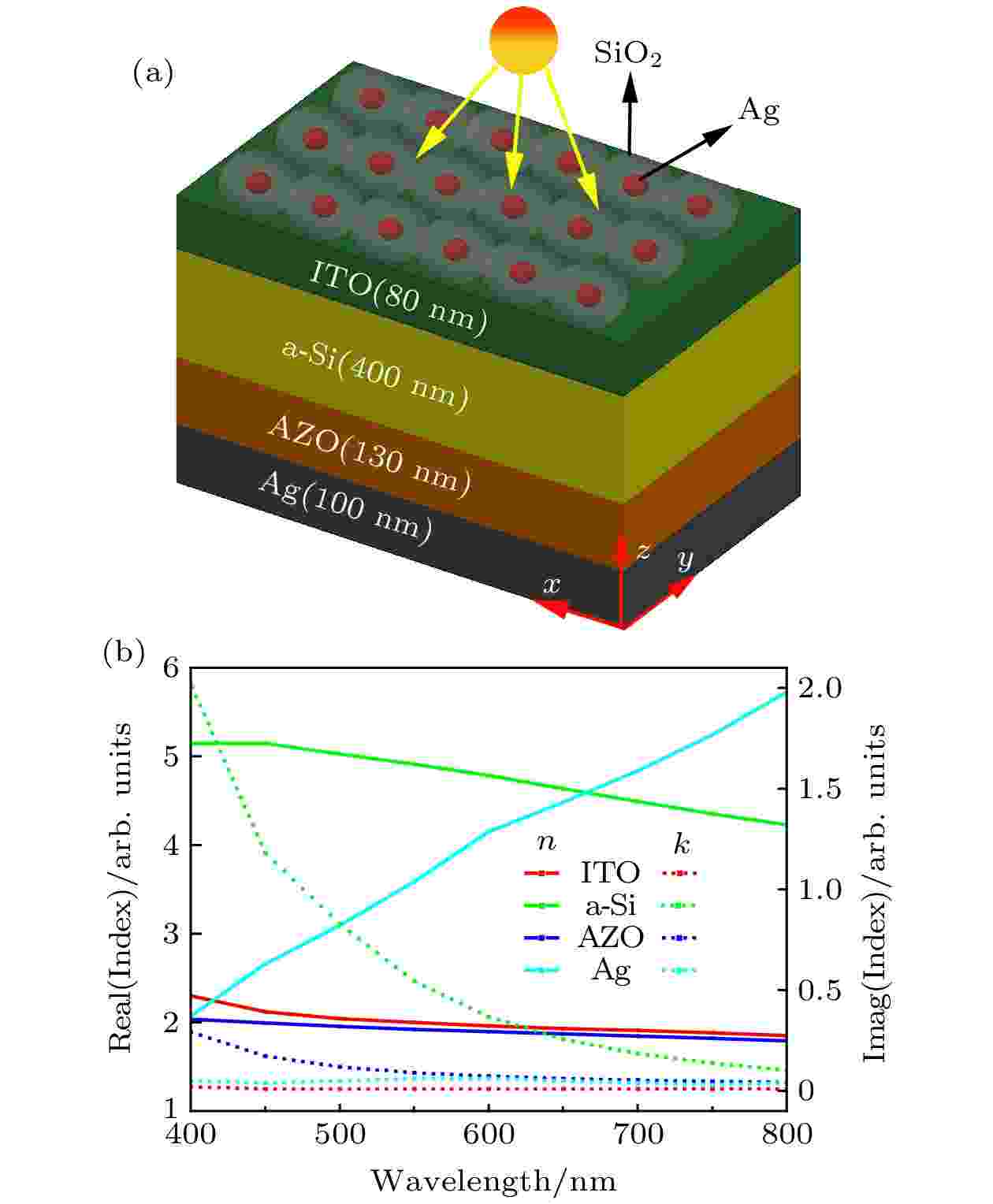
2020, 69 (18): 188801.
doi:10.7498/aps.69.20200334
Abstract +
The coupled nano-structure Ag@SiO2has both plasmon excitation like metallic nanoparticles and diffraction scattering like a dielectric nanosphere, which effectively controls the propagation path and the energy distribution of incident light and shows great potential applications in light trapping for thin film solar cells. In this work, we construct a three-dimensional electromagnetic model based on the finite-difference time-domain (FDTD) and rigorous coupled-wave analysis (RCWA) method to investigate the regulation mechanism of Ag@SiO2coupling structure to the spectral response of amorphous silicon cells. By being optimally designed, a high-efficiency cell device is achieved. The results show that the transmitted light into the active layer reaches a maximum value when Ag and SiO2have their feature sizes of 18 and 150 nm, respectively. The absorption spectrum of the corresponding cell device also arrives at its maximum value. The photoelectric conversion efficiency is enhanced from 7.19% to 7.80%, with an increment of 8.48% compared with the flat solar cell with an equivalent thickness of absorbing layer.
REVIEW

2020, 69 (18): 187801.
doi:10.7498/aps.69.20200795
Abstract +
Metal halide perovskite nanocrystals (NCs) have attracted great attention in the fields of light-emitting diodes, lasers, X-ray imaging, solar cells and photoelectric detectors due to their excellent optoelectronic properties. Compared with organic-inorganic hybrid perovskite NCs, all inorganic perovskite CsPbX3(X= Cl, Br, I) NCs have good photoelectric properties and high stability. To further improve the photoluminescence (PL) quantum yields (QYs) and stability of CsPbX3NCs, researchers reduced the defects as nonradiative recombination centers in NCs by the following strategies: 1) surface treatment with different ligands; 2) control of synthesis conditions with halide rich compounds; 3) doping of metal ions. Among them, metal doping is considered as a universal and effective way to adjust the optoelectronic properties of semiconductors. It is found that the type and the concentration of metal ions have great influence on the electronic band structure and PL performance of NCs after the metal ions have been doped into CsPbX3NCs. At the same time, compared with II-VI and III-V semiconductors, the unique structure of all inorganic perovskite NCs makes the doping of metal ions easier. Appropriate doping can not only enhance the intrinsic optical properties of the NCs without affecting their crystal structure, but also introduce new electronic energy levels into the NCs and new luminescent properties of doped metal ions. Based on metal ions doping strategy, the PLQYs of doped CsPbX3NCs have been enhanced to nearly 100%. In this work, we summarize recent advances in metal doping of the four typical kinds of perovskite NCs, including CsPbCl3, CsPbBr3, CsPbI3, and Mn2+doped CsPbX3, and discuss the physical mechanisms of the improved properties through doping metal ions. It should be pointed out that the doping of some metal ions such as Ni2+and Cd2+into the above four kinds of NC systems can effectively passivate NC defects, thus improving the PL QY and stability of NCs. In addition, we put forward some personal perspectives on the future research subjects of interest and directions of metal doping for enhanced PL of CsPbX3NCs, which needs to be further explored in order to promote extensive application of perovskite NCs to various optoelectronic devices.
ELECTROMAGNETISM, OPTICS, ACOUSTICS, HEAT TRANSFER, CLASSICAL MECHANICS, AND FLUID DYNAMICS

2020, 69 (18): 184101.
doi:10.7498/aps.69.20200415
Abstract +
Two kinds of two-dimensional photonic crystal with hexagonal honeycomb lattices are constructed in which the scatterer and the matrix materials are reversed. Due to the symmetry of special point group, the lattices have p and d orbitals in the center of Brillouin region, which are similar to those in the electronic system. With the structure reversal, the p and d orbitals are also directly inverted. Quantitative analysis shows that the orbital inversion is due to the inversion of air band and medium band because of the local resonance effect in the low frequency bands. Based on the parity properties of p and d orbitals, the pseudo spin states are constructed by analogy to the quantum spin Hall effect in electronic systems. The analysis of the effective Hamiltonian atΓpoint shows that the topological phase transition caused by orbital inversion is revealed. The pseudo spin edge states construct an optimal structure. The electromagnetic wave simulations and energy flow vector analysis show that the structure edge takes on the properties of quantum spin Hall effect, namely, the propagation direction is locked by the spin direction and the propagation is topologically protected. The results also show that the quantum spin Hall effect can be realized without undergoing the closing of gap. The comparison among similar researches indicates that the realization of the pseudo spin states does not need the deformation of lattice, and the structure proposed in this work possesses the characteristics of simple design, wide band gap and strong edge localization.
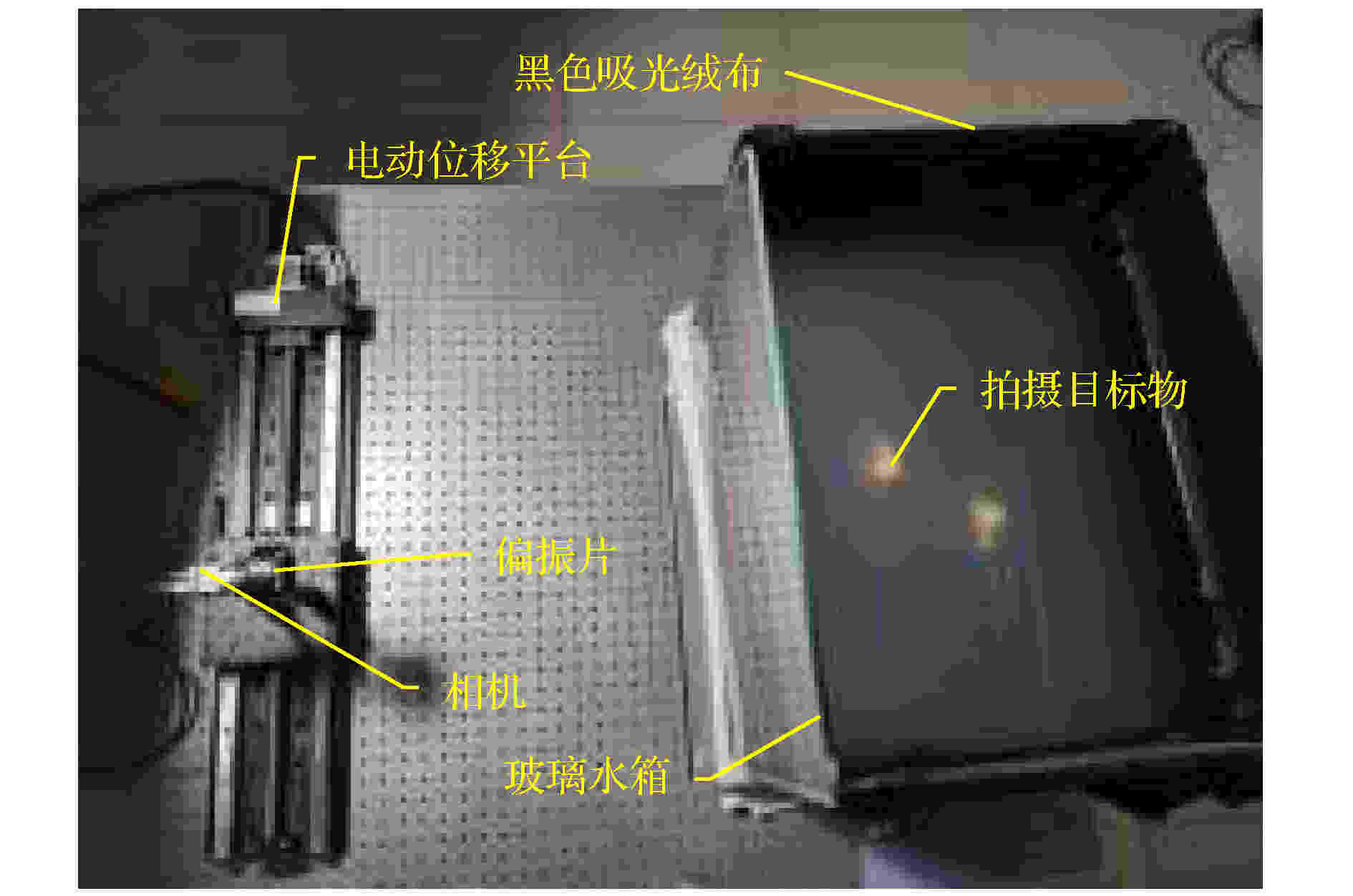
2020, 69 (18): 184202.
doi:10.7498/aps.69.20200471
Abstract +
Underwater optical imaging is the key technology to explore the underwater mystery. However, due to the absorption and backscattering effects of the media in the underwater environment, the image acquired by the detector will be severely degraded. In order to obtain the effective underwater scene information, it is necessary to restore the acquired underwater image. The restoration technology based on differential polarization is one of the main methods of restoring the underwater images, which can suppress the background scattered light by the common-mode suppression between orthogonal polarization graphs, thus realizing the restoration of underwater image. However, the relevant research shows that the restoration effect of this method is general for the underwater non-uniform light field. The main reason is that the estimation errors of polarization degree and background scattering intensity under the condition of the non-uniform underwater light field are large. Out of the above problem, in this paper we present the multiple aperture underwater imaging technology of fused polarization information. The method uses the camera array to realize the large virtual aperture imaging system, thus obtaining the wide-angle light field information, and then to fuse the depth information of the scene to realize the accurate estimation of background scattering light intensity and polarization degree under the condition of underwater non-uniform light field. The estimated parameter value can better reflect the global characteristics of the scene. Through the imaging experiments on the targets with different polarization degrees in the turbid underwater environment, comparing with the current advanced restoration algorithm, the results show that the proposed method can effectively solve the problems of background scattering and polarization degree significant estimation error caused by non-uniform underwater light field, and obtain high-quality restoration results. Through the contrast imaging experiment of the target in the underwater environment with different turbidity concentrations, the results show that with the increase of turbidity concentration of the water, the image recovery effect of the method in this paper is gradually weakened. However, it still has a good restoration effect at a large concentration. At the same time, imaging experiments are conducted on targets in underwater environments with different sediment concentrations. The results show that the method proposed in this paper can also obtain a better restoration image in the turbid water environment containing sediment.
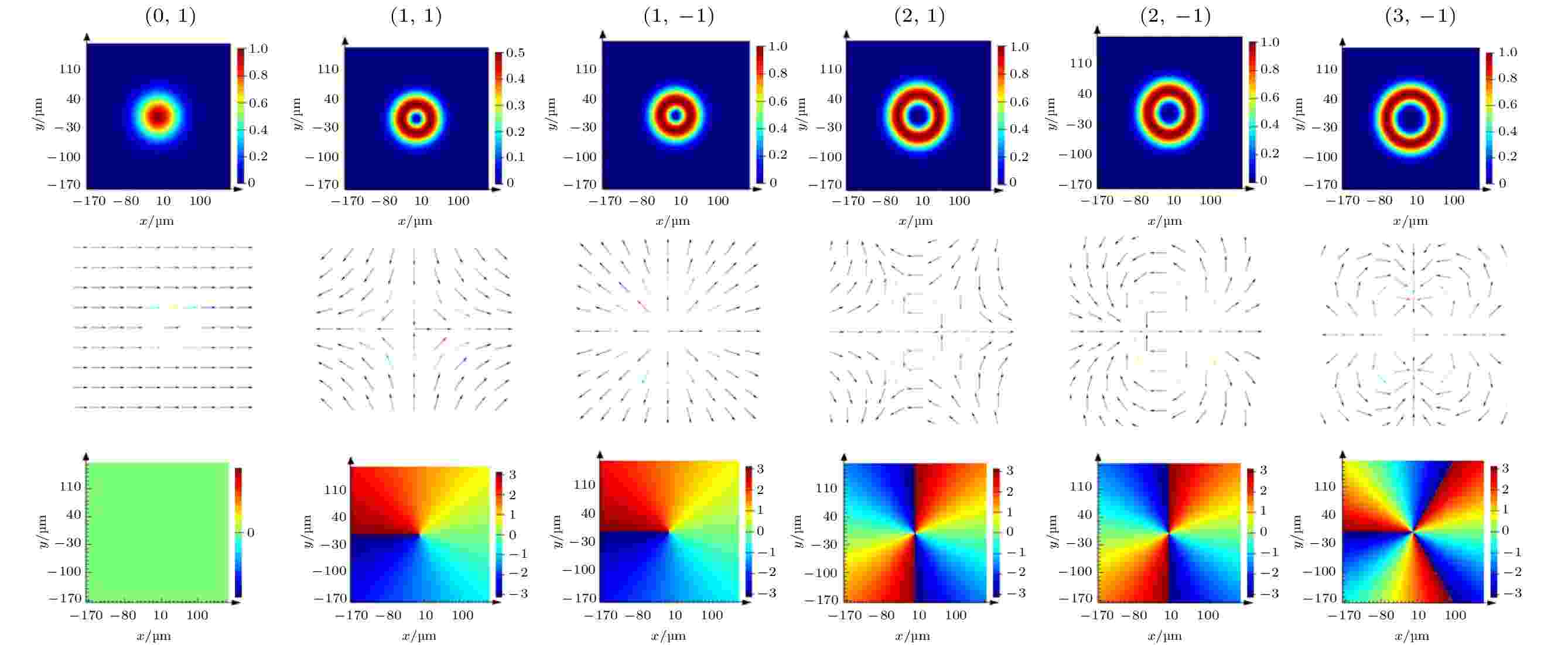
2020, 69 (18): 184203.
doi:10.7498/aps.69.20200695
Abstract +
We theoretically and experimentally investigate a method of exciting multipole plasmons, including terahertz dark spoof localized surface plasmon (Spoof-LSP) modes, by using normally incident terahertz vortex beam. The vortex beam with angular intensity profile and phase singularities, has well-defined angular momentum which can be decomposed into the polarization-state-related spin angular momentum (SAM) for characterizing the spin feature of photon, and the helical-wavefront-related orbital angular momentum (OAM) that is characterized by an integer
$ (l) $
, called the topological charge. By illuminating terahertz vortex beam on the metallic disk with periodic subwavelength grooves normally, we find that the terahertz dark multipole plasmons can be excited by the terahertz vortex beam carrying different OAM and SAM. We analyze the correspondence between the spin and orbital angular momentum of vortex beam and the excited dark multipolar plasmon modes. In the experiment, a terahertz stepped spiral phase plate (SPP) with high transmission and low dispersion based on the Tsurupica olefin polymer is developed and the stepped SPP can generate a terahertz vortex beam having a topological charge of 1. Then, we further study the excitation of dark multipolar Spoof-LSPs by utilizing the stepped SPP in combination with the near-field scanning terahertz microscopy. The collimated terahertz wave, which is radiated from a 100 fs (λ= 780 nm) laser pulse pumped photoconductive antenna emitter, is converted into terahertz circular polarized light (CPL) which can carry SAM by the combination of the quarter wave plate and the polarizer, and then terahertz CPL impinges on the stepped SPP, producing the terahertz vortex beam which can carry OAM. The spatial two-dimensional electric field distribution is collected in steps of 0.02 mm along thex-direction andy-direction by a commercial terahertz near-field probe which is located close (≈ 10 μm) to the one side of polyimide film by three-dimensional electric translation stage and a microscope (FORTUNE TECHPLOGY FT-FH1080). The experimental results are in good agreement with simulations. We believe that our method will open the way for detailed research on the terahertz physics, plasma and imaging fields.
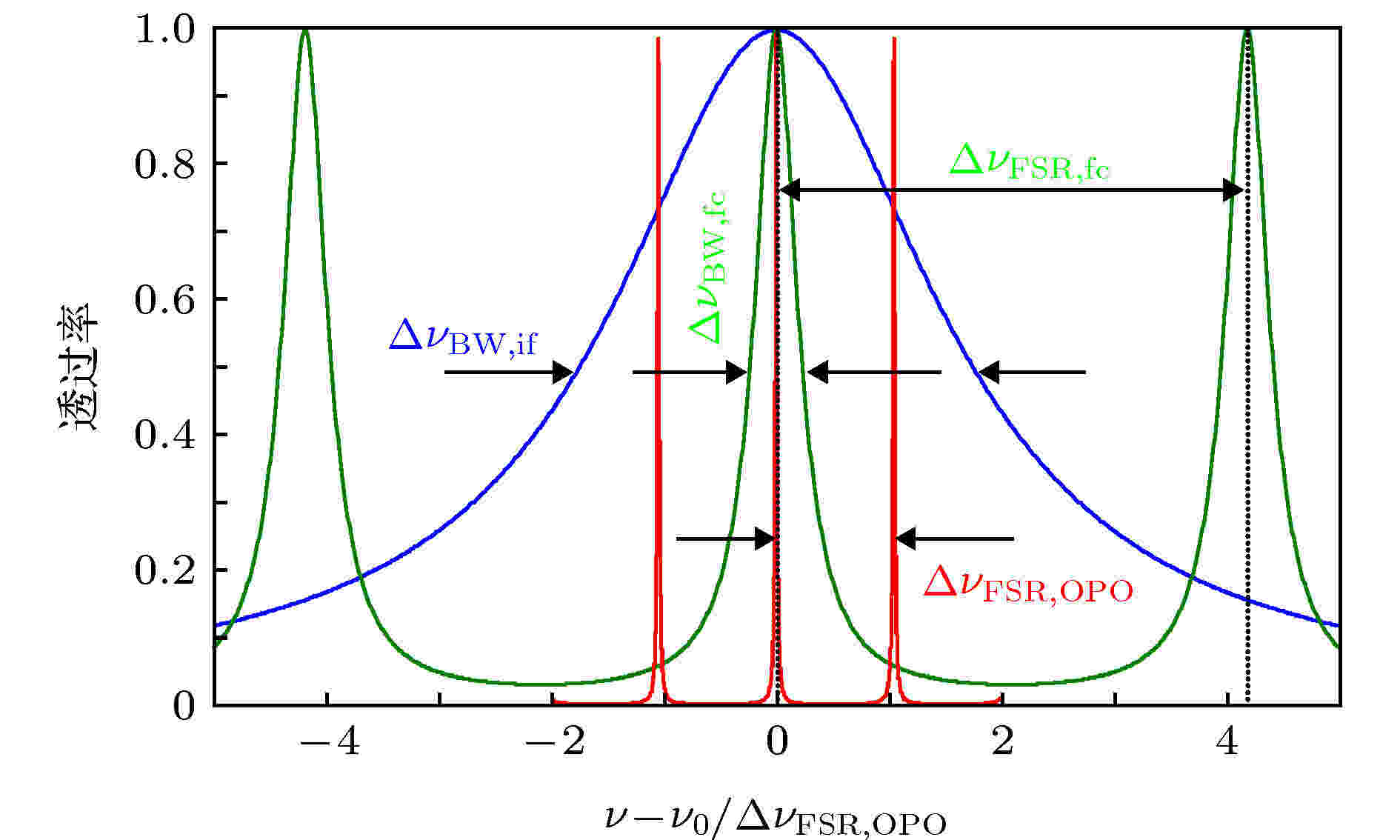
2020, 69 (18): 184204.
doi:10.7498/aps.69.20200589
Abstract +
Optical Schrödinger cat state is not only one of the basic elements of quantum mechanics, but also a pivotal resource of continuous-variable quantum information. The non-Gaussian operation in its preparation can also be a key technology in distilling continuous-variable squeezing and entanglement. In the experimental preparation, a small part of a beam of vacuum squeezing is separated and detected as the trigger of appearance of Schrödinger cat state. Filter operation in the trigger optical path is important since it affects dark counts of single photon detector, frequency mode matching of trigger mode and signal mode, and preparing rate of the Schrödinger cat state, etc. In this paper, we describe the design of optical filter in the trigger path and the measurement of the filter cavity length. According to the design, filter cavity length
$ {l_{{\rm{FC}}}}$
should satisfy
$ {\rm{189}}\;{\text{μm}} > {l_{{\rm{FC}}}} > {\rm{119}}\;{\text{μm}}$
. This cavity length is too small to be measured with a ruler. To measure the cavity length, we introduce an optical method, in which Gouy phases of Hermite Gaussian transverse modes TEM00and TEM10are used. When the cavity length is scanned, resonant peaks and the corresponding scanning voltages are recorded. From theoretical derivation, the cavity length is related to the filter cavity piezo response to the scanning voltage
$ {\varPsi '_{\rm{G}}}$
, the slope rate of piezo scanning voltage
$ U'$
, and the time distance between TEM00and TEM10resonant peaks
$ \Delta t$
. The finally measured cavity length is
${l_{{\rm{FC}}}} = ({\rm{141}} \pm 28)~{\text{μm}}$
, which satisfies the design requirement. The measurement error mainly originates from inaccurate fitting of
$ {\varPsi '_{\rm{G}}}$
and
$ U'$
, and readout error of
$ \Delta t$
. It is shown that the error of
$ {\varPsi '_{\rm{G}}}$
is dominant since less data are used in the curve fitting. The measurement error is expected to be reduced if much more data of piezo response to scanning voltage are collected and used to fit
$ {\varPsi '_{\rm{G}}}$
with higher order polynomials. The proposed measurement method of short cavity length needs neither wide tuning laser nor any peculiar instrument, and does not depend on any dispersion property of the cavity, and hence it has a certain generality. It can be hopefully used in many other optical systems, such as cavity quantum electrodynamics, where ultrashort cavity plays a central role.
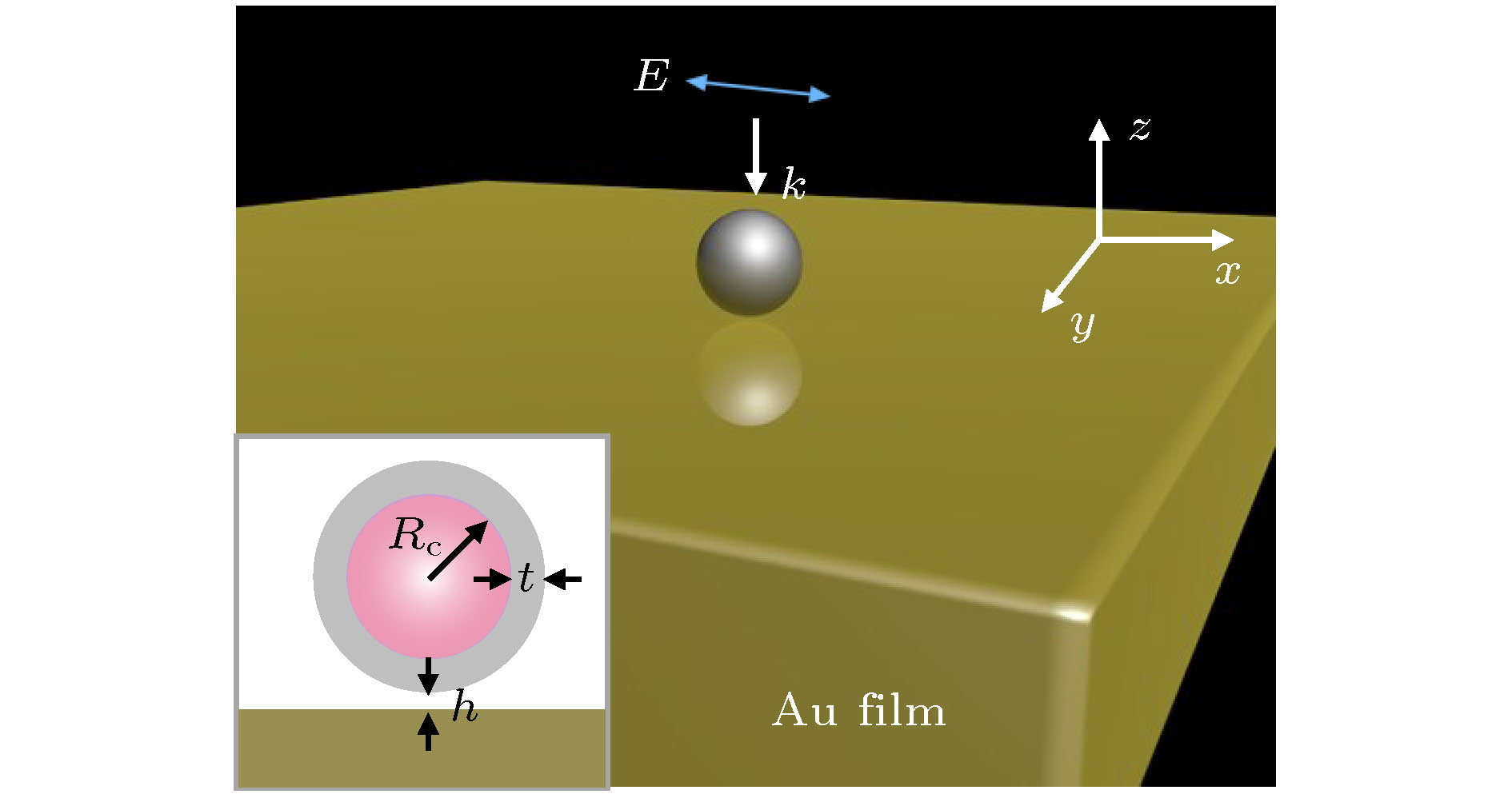
2020, 69 (18): 184206.
doi:10.7498/aps.69.20200214
Abstract +
Manipulating the core-shell structure with the optical force has been extensively studied, giving birth to applications such as particle sorting, biomarkers and drug delivery. Tailoring the optical force exerted on the core-shell above the metallic film remains unexplored, despite the obvious benefits for both fundamental research and applications including strong coupling, surface enhanced spectroscopy, nanolaser, and nanoscale sensing. In this work, we systematically investigate the optical force exerted on a dielectric/metal core-shell above a gold film by utilizing the Maxwell stress tensor formalism. It is found that at the present gold substrate, the optical force on the core-shell can be one order of magnitude larger than that on the individual core-shell due to the strong coupling between the core-shell and the gold film. Interestingly, the direction of the optical force can be reversed from positive to negative by distributing the local field from the upside of core-shell to the structure gap through changing the excitation wavelength. Furthermore, we demonstrate that the magnitude and peak wavelength of the optical force can be well controlled by altering the structure gap, the size and refractive index of the core. More specifically, it is found that the coupling strength between the core-shell and the gold film decreases with the gap size increasing. As a result, we observe the blue shift of bonding mode and the decrease of local field in the gap, which leads the force peak wavelength to be blue-shifted and the force peak magnitude to decrease, respectively. Also, by increasing the radius and refractive index of the core, a red shift of force peak is accompanied with the red shift of the bonding mode. In addition, the force peak magnitude follows the same trend as the total local field enhancement factor when the radius and refractive index of the core change. We hope that our results open the way to control the cavity size of particle on film structure, which would be beneficial for tailoring the light matter interaction even down to single molecular level and promises to have the applications in novel functional photonic devices.
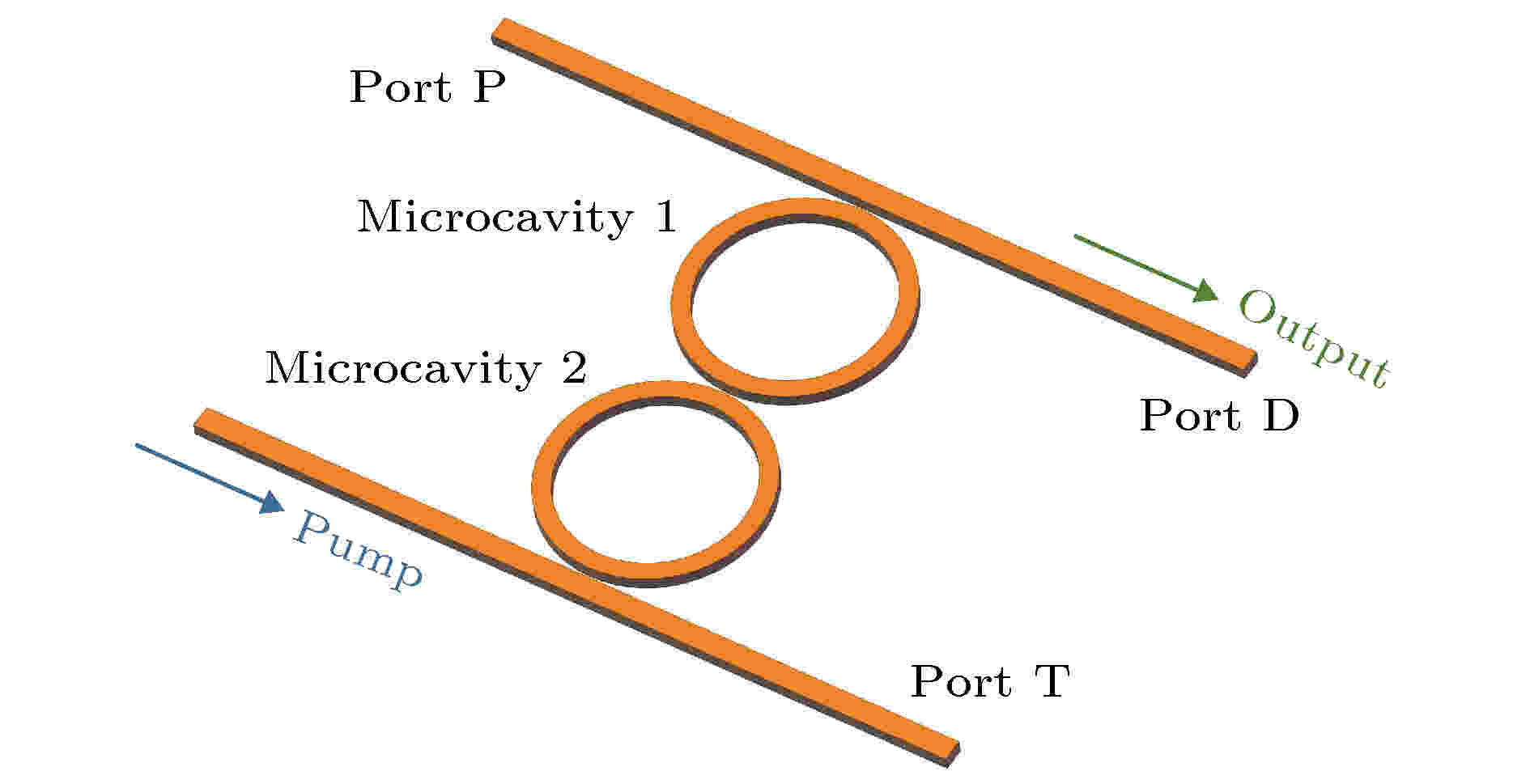
2020, 69 (18): 184207.
doi:10.7498/aps.69.20200530
Abstract +
Different frequency detuning can excite different working mode in a dual coupled optical microcavities. Based on the nonlinear Schrödinger equations of dual coupled field, and by using the split-step Fourier method, the optical field evolution in the microcavities is analyzed under the condition of both positive and negative tuning, and various optical distributions are generated in the process of frequency tuning. Simulation results indicate that the field can develop into the bright soliton in the region of positive tuning. However, the region in which the bright soliton is maintained is small, and the field in the microcavities grows into direct current (DC) distribution because of the serious frequency detuning. In the region of negative tuning, the field of “turning pattern” with high power is generated. There is only chaos inside the microcavities without frequency detuning or the detuning parameters close to 0. In addition, under the condition of strong coupling, the bright soliton and the “turning pattern” cannot be excited. Even stronger coupling leads to optical field in the form of DC directly. After the bright soliton exciting in the microcavity, it can be preserved by selecting appropriate detuning parameters and pump power. Moreover, the bright soliton can be changed into “turning pattern” with low power by continuously changing the detuning parameter of the first microcavity. Theoretical analyses are significant for experimental research on the dual coupled microcavities.
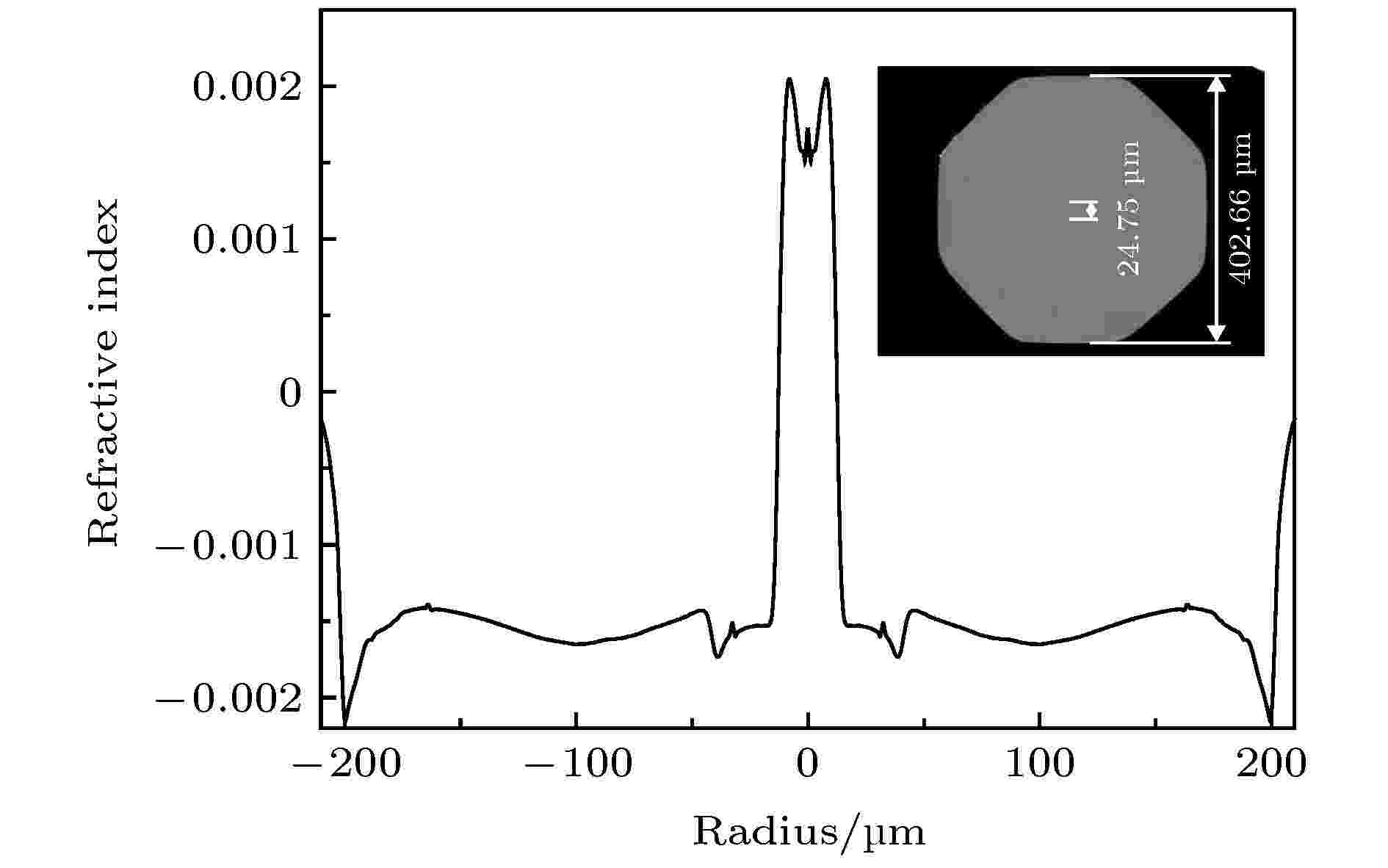
EDITOR'S SUGGESTION
2020, 69 (18): 184209.
doi:10.7498/aps.69.20200466
Abstract +
In the past decades, thulium-doped fiber lasers (TDFLs) operating in an eye-safe range have attracted considerable attention, for they have extensive applications such as LIDAR, free space communication, medical diagnostics and pumping source for holmium-doped fiber laser or optical parameter oscillator. In this paper, we report a high power all-fiberized TDFL based on main-oscillator power-amplifier (MOPA) configuration. The preform is fabricated by the modified chemical vapor deposition method combined with solution doping technique and drawn into a core/clad size of 25/400 μm. The numerical aperture of the TDF is 0.1. The concentration of Tm2O3and Al2O3are 2.6 wt% and 1.01 wt%, respectively, measured by an electron probe micro-analyzer. The cladding absorption is 3 dB/m at 793 nm measured by cut-back method. The oscillator consists of 8 m 25/400 TDF mentioned above and a pair of fiber Bragg gratings. The oscillator yields maximum power of 91 W with pump power of 202 W and a 3 dB spectral bandwidth as narrow as 75 pm. In the amplifier stage, the bi-directional pumping scheme is employed. The narrow linewidth seed with output power of 57 W is scaled to 530 W through one-stage amplification, corresponding to a slope efficiency of 50%. The central wavelength of the Tm-doped MOPA is 1980.89 nm and the linewidth is broadened to 0.11 nm at 530 W. The measuredM2factor at 100 W is less than 1.3. Neither obvious amplified spontaneous emission nor non-linear effect is observed, and the output power is only limited by pump power. To the best of our knowledge, this is the highest output power of TDF at present.
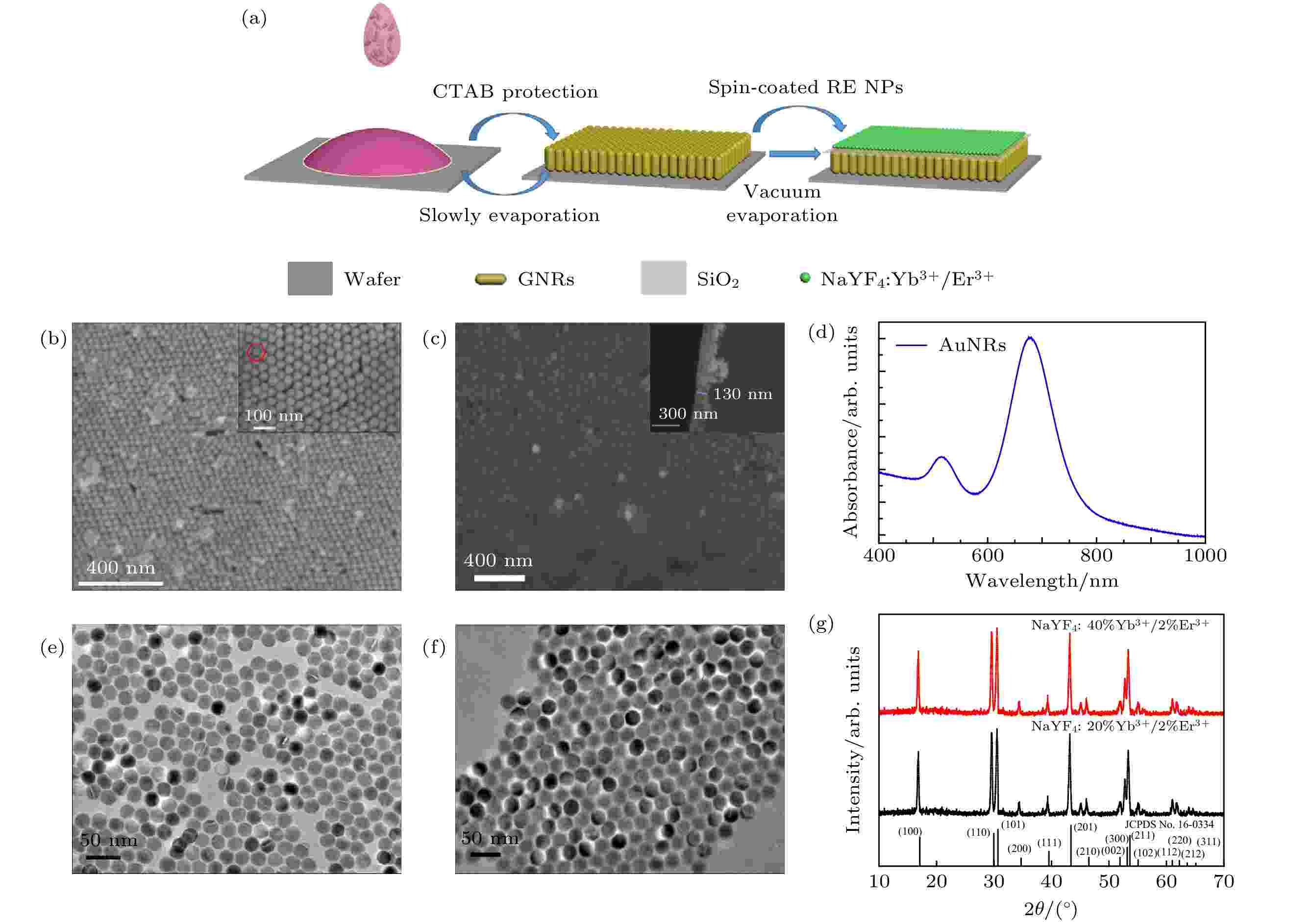
EDITOR'S SUGGESTION
2020, 69 (18): 184213.
doi:10.7498/aps.69.20200575
Abstract +
The plasmon resonance effect is one of the effective ways to enhance the upconversion (UC) luminescence, which is realized by enhancing the electromagnetic field from incident light interacting with free electrons of AuNRs surface. In this work, a series of GVA@SiO2@NaYF4:Yb3+/Er3+composite structures with different thickness values of SiO2isolation layer is successfully built from self-assembled gold nanorods, steamed SiO2, and spin-coating rare-earth nanocrystals. The results of the SEM indicate that the size of gold-nanorods is approximately 22 nm in diameter and 65 nm in length. The X-ray diffraction and transmission electron microscope results demonstrate that the NaYF4:Yb3+/Er3+nanocrystals possess hexagonal-phase structure with a size of about 20 nm. Under 980 nm near-infrared (NIR) excitation, the UC emission characteristics of GVA@SiO2@NaYF4:Yb3+/Er3+composite structure are studied by using a confocal microscope spectroscopic test system, and regulated by changing the thickness of SiO2isolation layer. The results indicate that the UC emission intensity of NaYF4:20%Yb3+/2%Er3+nanocrystals is enhanced by about 8.8 times, and the enhancement factor of red UC emission intensity is about 16.2. In order to further prove the enhancement effect of the red UC emission, the GVA@SiO2@NaYF4:40%Yb3+/20%Er3+composite structure with red UC emission is constructed in the same way. It can be found that the UC emission intensity of NaYF4:40%Yb3+/20%Er3+nanocrystals is enhanced by 8.7 times and the red UC emission intensity is raised by about 9.7 times under the 980 nm NIR excitation. The corresponding excitation enhancement mechanism is simulated according to the power excitation dependence. And it is found that the rate of UC emission decreases and the R/G ratio also decreases with the excitation pump power increasing. The analysis of the above results shows that the excitation enhancement plays a leading role and is accompanied by emission enhancement. Meanwhile, the study of Er3+ion dynamic process indicates that the Er3+ion transition rate is accelerated due to the coupling from UC emission peaks and gold nanorod absorption peaks in GVA@SiO2@NaYF4:40%Yb3+/20%Er3+composite structure. The enhancement mechanism of UC emission is also simulated, which further proves that the excitation enhancement is dominant. This kind of composite structure can not only help us to further understand the physics mechanism of the plasmon-enhanced UC luminescence but also promote the applications of rare-earth materials in medical imaging and fingerprint recognition.
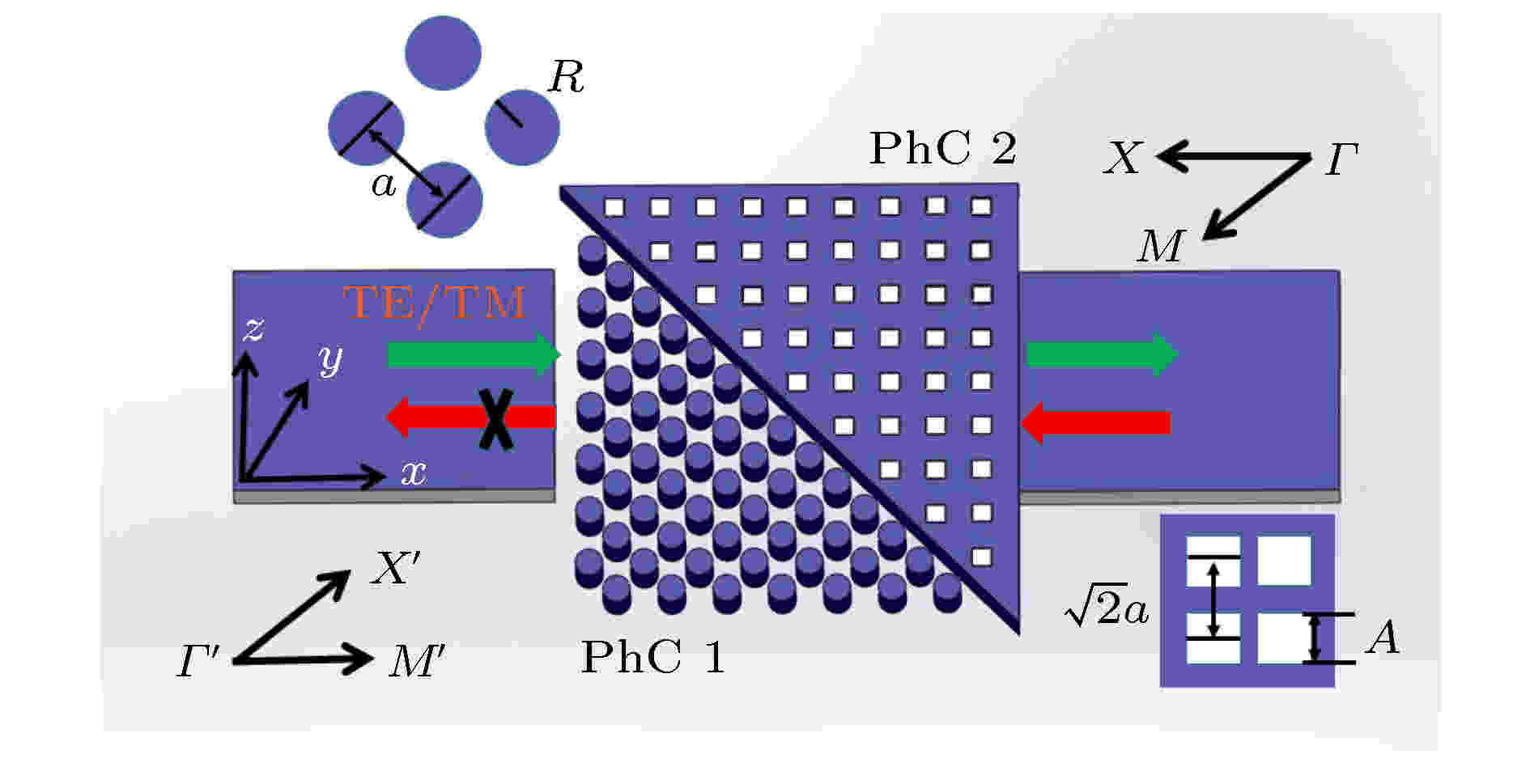
EDITOR'S SUGGESTION
2020, 69 (18): 184214.
doi:10.7498/aps.69.20200538
Abstract +
Recently, quantum computing and information processing based on photons has become one research frontier, attracting significant attentions. The optical asymmetric transmission devices (OATD), having similar function to the diode in electric circuitry, will find important applications. In particular, the OATDs based on nanophotonic structures are preferred due to their potential applications in the on-chip integration with other photonic devices. Therefore, there have been numerous applications of OATDs based on different nanostructures, including composite grating structures, metasurfaces, surface plasmon polaritons, metamaterials, photonic crystals (PhCs). However, in general, those designs show relatively low forward transmittance (< 0.5) and narrow working bandwidth (< 100 nm), and they are able to work with only one polarization state. This makes the current OATDs unsuitable for many applications. To solve this challenge, here we design a two-dimensional (2D) PhC heterostructure based on the self-collimating effect and bandgap properties. The PhC heterostructure is composed of two square lattice 2D PhCs (PhC 1 and PhC 2) on a silicon substrate with different lattice shapes and lattice constants. The PhC 1 is composed of periodically arranged silicon cylinders in air. Meanwhile, the PhC 2 is an square air hole array embedding in silicon. The two PhCs are integrated with an inclined interface with an angle of 45° with respect to the direction of incident light. The plane wave expansion method is used to calculate the band diagrams and equal frequency contours (EFCs) of the two PhCs. As the propagation directions of light waves in PhCs are determined by the gradient direction of the EFCs, we are able to control the light propagation by controlling the EFCs of PhCs. By engineering the EFCs, the PhC 2 shows strong self-collimation effect in a broad wavelength range with a central wavelength of 1550 nm for both TE and TM polarization. By self-collimating the forward incident light from different incident angles to couple to the output waveguide, we are able to significantly increase the forward transmittance to > 0.5 for both TE and TM polarized light. Meanwhile, the backward transmittance can be effectively cut off by the unique dispersion properties of the PhC heterostructures. In this way, the heterostructure is able to achieve polarization independent asymmetric transmission of light waves in a broad wavelength range. To visualize the light propagation in the PhC heterostructure, we use the finite-difference-time-domain method to calculate the electric intensity distributions of the forward and backward propagation light of both TE and TM polarization at a wavelength of 1550 nm. Strong self-collimation effect of forward propagation light and the nearly complete blockage of backward propagation light can be identified unambiguously in the intensity plots, confirming the theoretical analysis. The calculation of transmittance and contrast ratio spectra show that the asymmetric transmission wavelength bandwidth can reach 532 nm with the forward transmittance and contrast ratio being 0.693 and 0.946 at an optical communication wavelength of 1550 nm for TE polarized light. On the other hand, for the TM polarized light, the asymmetric transmission wavelength bandwidth is 128 nm, the forward transmittance and contrast ratio are 0.513 and 0.972, respectively, at 1550 nm wavelength. Thus, it is confirmed that the PhC heterostructure achieves highly efficient, broadband and polarization independent asymmetric transmission. Finally, to further improve the forward transmittance of the TE polarized light, we modulate the radius of the front row of photonic lattice of PhC 1 at the interface. It shows that the forward transmittance can be further improved to a record high value of 0.832 with a bandwidth of 562 nm for TE polarized light. Our design opens up new possibilities for designing OATDs based on PhCs, and will find broad applications, for the design can be realized by current nanofabrication techniques.
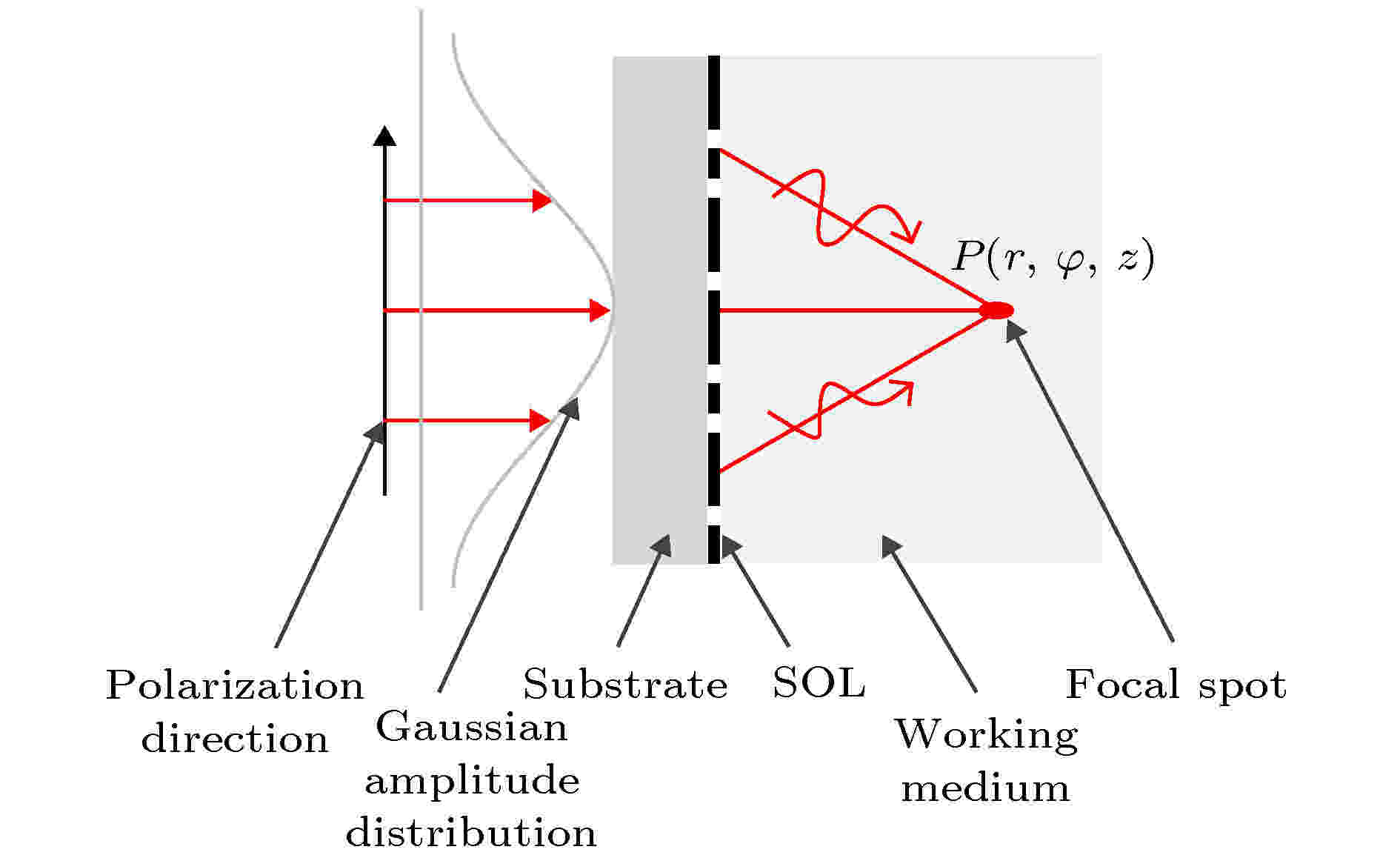
2020, 69 (18): 184215.
doi:10.7498/aps.69.20200577
Abstract +
Super-oscillatory lens (SOL), a new type of planar optical element developed in recent years, may play an important role in the integrated optics, microscopy, advanced sensor, and astronomy. Based on the vectorial angular spectrum theory and genetic algorithm, both binary amplitude-type and phase-type SOLs are designed. Various sub-diffraction focusing properties can be realized by optimizing the design procedure. In order to investigate the focusing characteristics of SOLs under different illumination conditions, rigorous electromagnetic simulation calculations of the diffracted focusing light field are implemented by the finite-difference time-domain method. The results show that when the beam waist radiusw0of the illuminating laser is less than the SOL radiusa, not only the capability of super-diffraction limit focusing will decrease significantly, but also the intensity of the focal spot will attenuate by more than 50%. Comparing with the amplitude-type SOL, the waist radiusw0has a strong effect on the phase-type SOL and causes a significant focus to shift in the positive direction. However, ifw0is larger than 2a, the ideal focusing characteristics of SOL can be maintained. Under the condition of oblique illumination, the high numerical aperture amplitude-type SOL generally only allows a small inclination angle of less than 10°, while the phase-type SOL has a wide inclination adaptability (can exceed 40°) regardless of the numerical aperture. For the latter, the focal spot will expand laterally and the intensity will decrease sharply with the increase of inclination angle. As for low numerical aperture phase-type SOL, the focusing characteristics, including focal spot size, focusing intensity and the angular position of the focus, can keep stable within an inclination angle of 18°. For imaging infinitely distant objects, the oblique illumination will produce a fluctuating field curvature and significant negative distortion for high numerical aperture SOLs, while for the low numerical aperture SOLs, the field curvature increases with inclination angle increasing and the distortion disappears almost. The research results of this paper provide an important theoretical basis for practical applications of super-oscillatory lens in the fields of sub-diffraction light focusing, super-resolution microscopic imaging, and micro-nano processing of femtosecond laser direct writing.
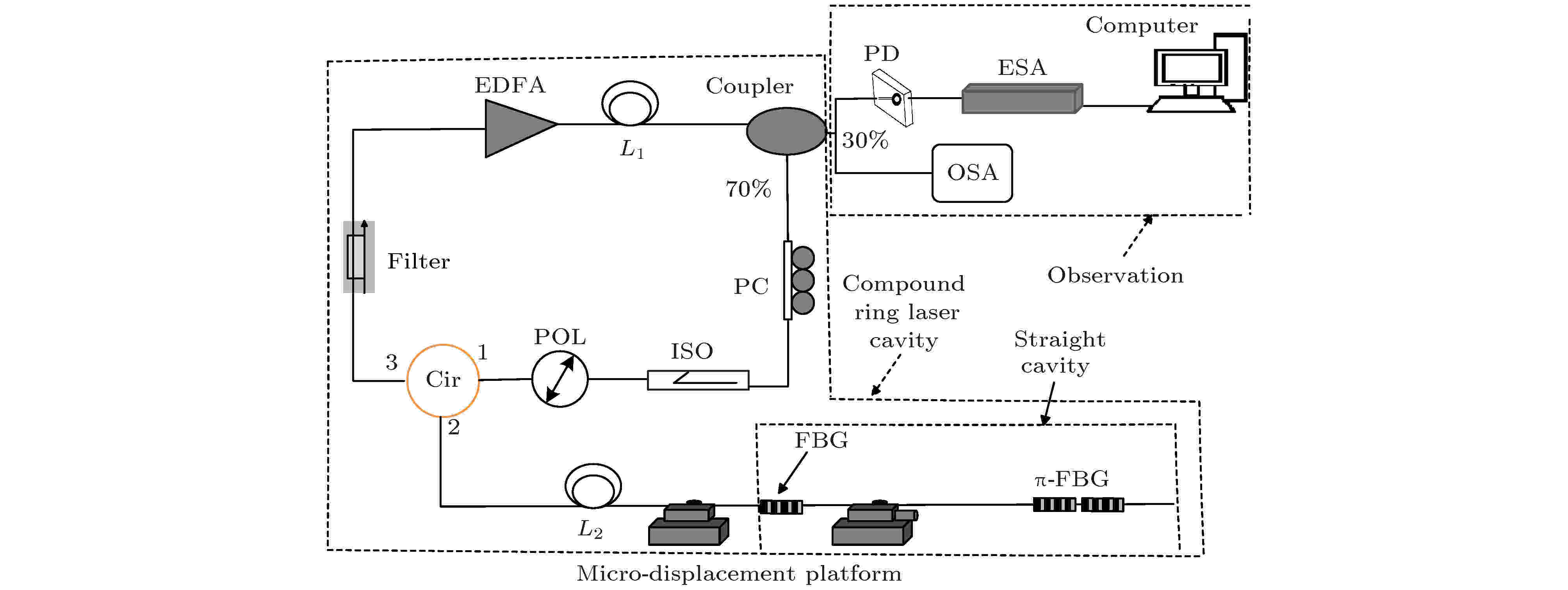
2020, 69 (18): 184217.
doi:10.7498/aps.69.20200385
Abstract +
A novel fiber sensor based compound ring laser cavity with linear variation of frequency is proposed and demonstrated experimentally. The compound ring laser cavity is comprised of a ring cavity and a straight cavity. This system can generate the beat frequency spectrum by employing an erbium doped fiber amplifier, a fiber Bragg grating is used as a sensor head and the straight cavity reflector, a π phase shifted fiber Bragg grating serves as a microwave photonic passband filter. The principle of the proposed sensor is theoretically analyzed, showing that as the displacement increases the beat frequency decreases, and there exists a linear relationship between displacement change and beat frequency shift. In experiment, it is shown that the sensor has a high sensitivity of about 86.19 kHz/mm and can achieve a good linear response (R2= 0.9973), and that the minimum monitored displacement is about 10 μm. The measurement results demonstrate that the sensor is accurate, sensitive, and the proposed sensor system has a compact and simple structure, which makes it convenient for more applications in future.
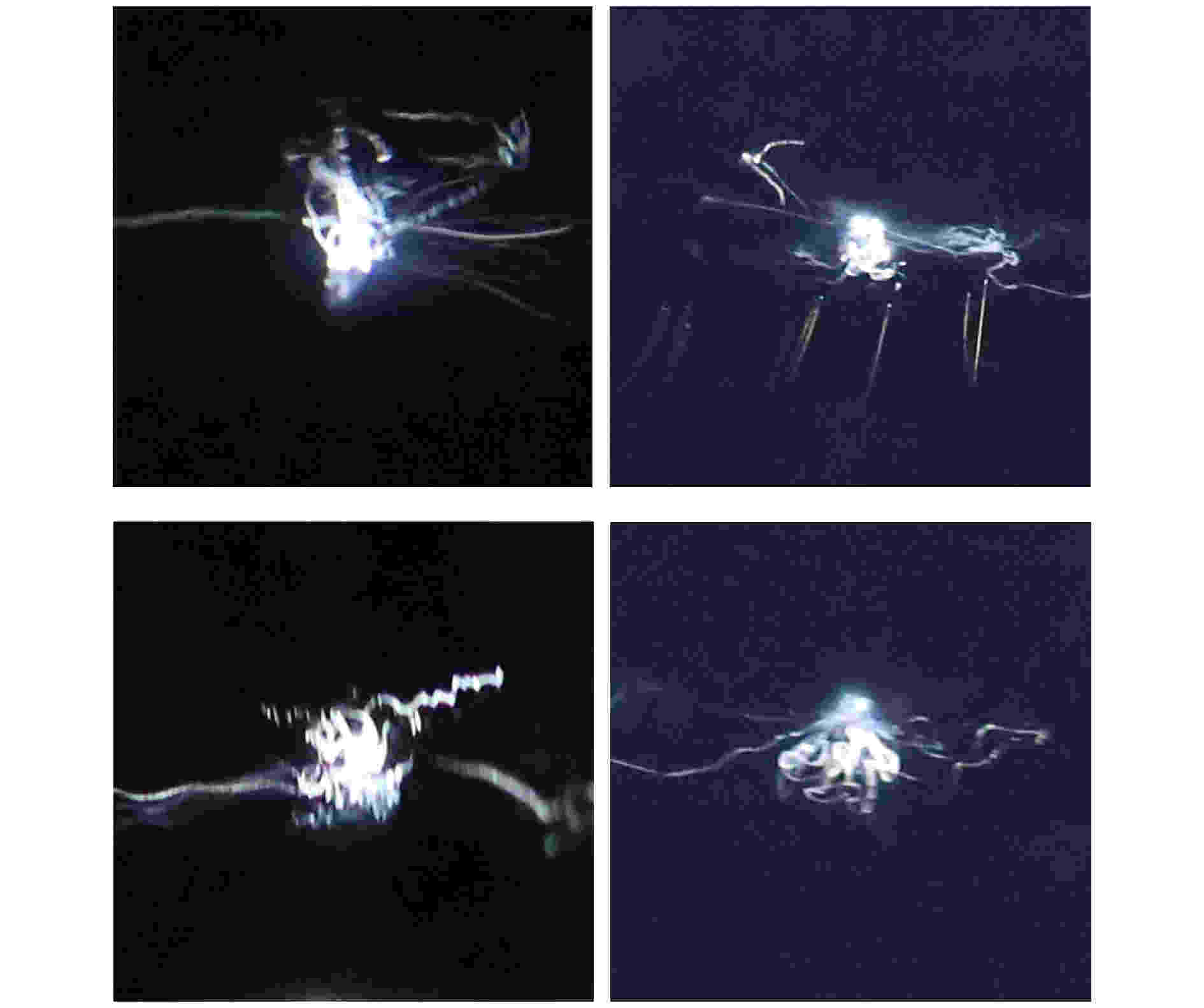
2020, 69 (18): 184301.
doi:10.7498/aps.69.20200381
Abstract +
In this paper, we observe and record the phenomenon of multi-bubble sonoluminescence in phosphoric acid solution which helium is injected into. It is found that a large number of cavitation bubbles are produced in the solution, which can form bubble groups with different shapes and structures, among them the spherical bubble group is a typical one. By the Rayleigh-Plesset equation of bubble group and any bubble in the group with the combination of van der Waals process equation, we study the variations of the bubble radius, temperature of the bubble, pressure pulse in the groups which are composed, respectively, of the bubbles with the same size and the same gas, the bubbles with the same size and different gases, the bubbles with different sizes and the same gas and the bubbles with different sizes and different gases. The results show that for the bubble group composed of the bubbles with the same size and the same gas and the bubble group composed of the bubbles with the same size and different gases, the gas contained in the bubble has a significant effect on the temperature inside the bubble, but has little effect on the bubble radius and the pressure pulse peak within the cluster. Bubble collapse depth of gas with low molecular weight is deeper than that of gas with high molecular weight, but the radius change of rebound stage is smaller than that of the latter. For the bubble group composed of the bubbles with different sizes and the same gas and the bubble group composed of the bubbles with different sizes and different gases, when the total number of bubbles in a bubble group is constant, for the case where there is only one large bubble in the group, the temperature in the large bubble is the highest, which can be higher than the temperature in a single bubble with the same size and the same gas; with the increase of the number of large bubbles in the group, the temperatures in the large and small bubbles both decrease rapidly: the temperature in the large bubbles approaches to the temperature in the bubbles of the bubble group composed of large bubbles with the same gas and the same size, and the temperature in the small bubble gradually approaches to the temperature in small bubble with the same gas under the radiation of many large bubbles. With the increase of the number of large bubbles, the peak value of the pressure pulse in the bubble group first decreases sharply to the inflection point, and then increases steadily to the peak value of the pressure pulse in the bubble group composed of large bubbles with the same gas and the same size. The proportion of large bubbles number in the bubble group has an important influence on the cavitation characteristics of the bubble group, only when the proportion of large bubbles reaches a certain value, can the bubbles of different sizes in the bubble group collapse at the same time, and this conclusion improve and perfect the previous conclusion. The results of this paper will provide some theoretical guidance and help to further explore the cavitation effect and luminescent mechanism of the bubble group.
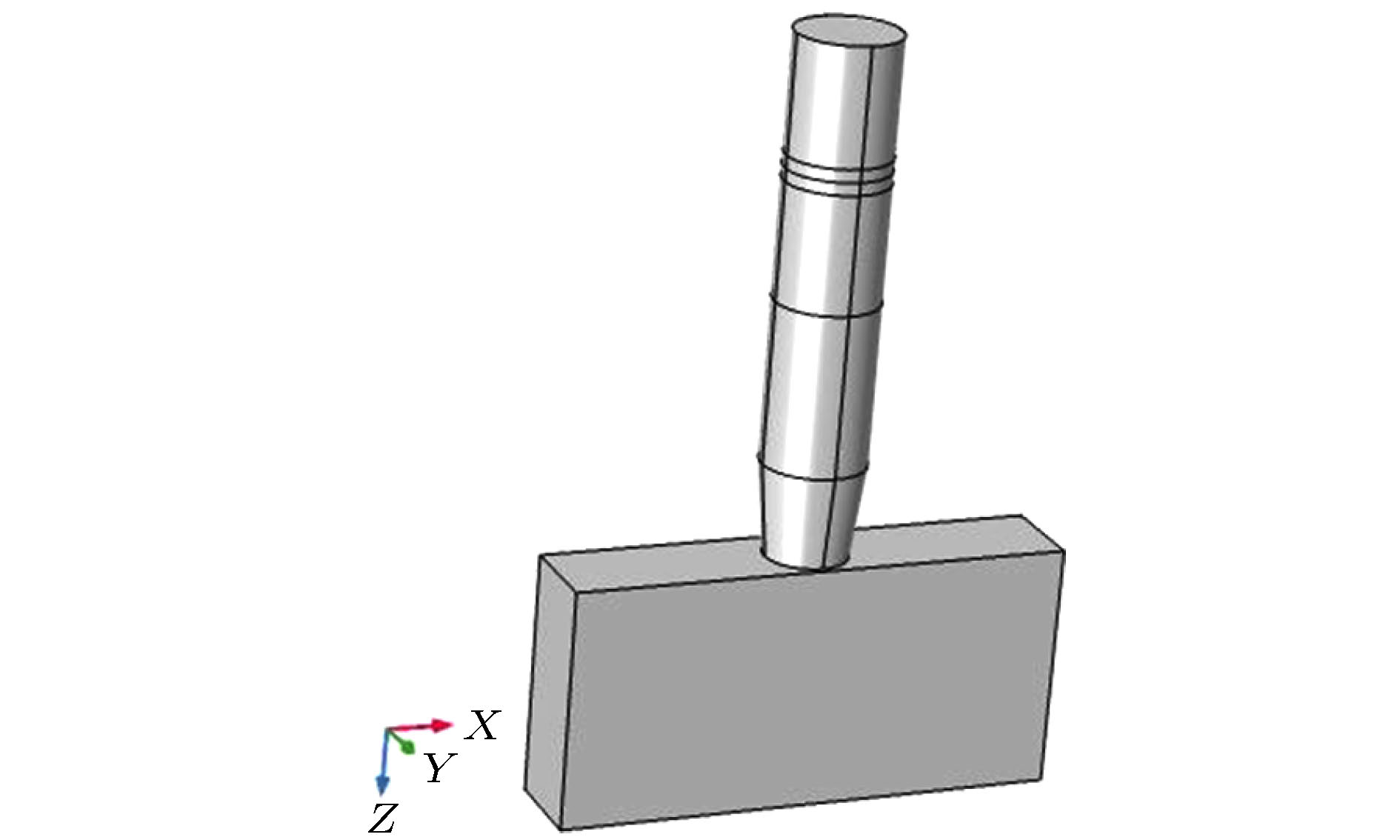
EDITOR'S SUGGESTION
2020, 69 (18): 184302.
doi:10.7498/aps.69.20200804
Abstract +
When the lateral dimension of the tool head is close to or greater than a quarter of the longitudinal wave length, the tool head will produce severe lateral vibration. The coupling of the lateral vibration and the longitudinal vibration makes the amplitude distribution of the tool head’s radiation surface uneven, which seriously affects the welding quality. To solve the problem of uneven amplitude distribution of the two-dimensional tool head’s radiating surface, in the paper we conduct an optimized design study on a two-dimensional ultrasonic plastic welding system. First, using the theory of phononic crystal dislocations, we construct a nearly periodic phononic crystal homogenous dislocation junction on a large-sized long strip tool head, and use the homogenous dislocation junction to change the regular lattice arrangement of the phononic crystal structure to adjust the position of the band gap and increase the width of the band gap, so that the operating frequency of the two-dimensional ultrasonic plastic welding system can be located in the band gap of the lateral vibration of the tool head, and the effective control of the lateral coupling vibration of the tool head can be achieved, thus optimizing the amplitude uniformity of the radiating surface of the tool head and increasing the amplitude gain. Although the homogenous dislocation junction structure improves the amplitude uniformity of the radiating surface of the tool head, the lateral dislocation effect of the homogenous dislocation junction causes the sound waves in the band gap frequency range to propagate along the dislocation channel, while the dislocation line channel is located in the middle of the tool head, which results in a larger displacement of the middle part of the tool head’s radiating surface, and a smaller displacement on both sides. Therefore, the further optimizing of the two-dimensional tool head is required. In this study, the nearly periodic phononic crystal inclined groove structure is used to better optimize the amplitude distribution uniformity of the radiating surface, and the influence of the inclined groove structure parameters on the longitudinal resonance frequency and amplitude distribution uniformity of the ultrasonic plastic welding system are analyzed, that is, the inclined groove can better improve the uniformity of the amplitude distribution than the straight groove, but the angle of inclination of neither the inner nor outer inclined grooves should be too large: the optimal range is 3°-6°. In addition, the difference in inclination angle between the inner inclined groove and the outer inclined groove should not be too large, and the angle difference from 0° to 2° is best. The simulation results show that the nearly periodic phononic crystal homogenous dislocation junction and inclined groove structure can optimize the two-dimensional ultrasonic plastic welding system, which provides a basis for further research on the theory of lateral vibration suppression.
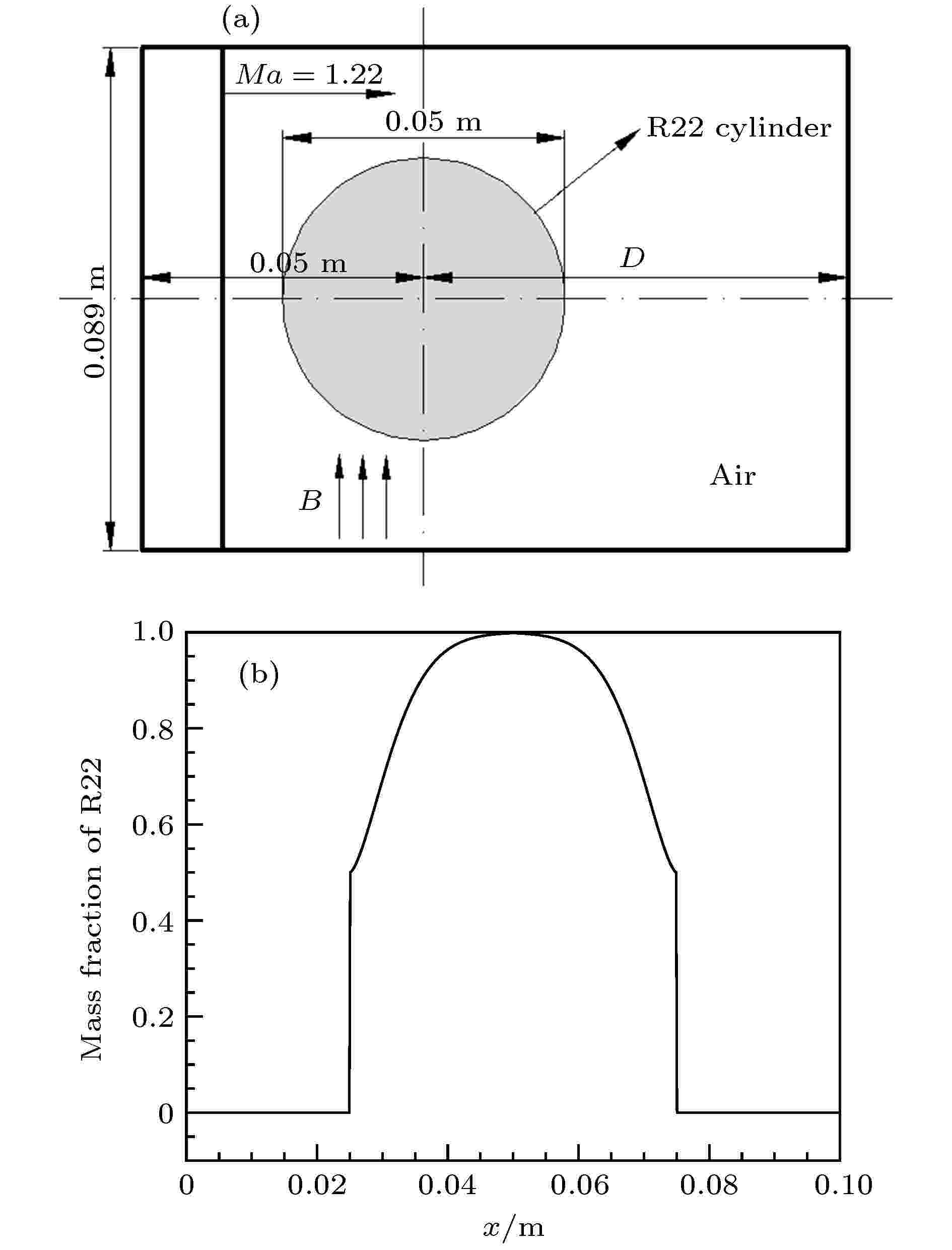
2020, 69 (18): 184701.
doi:10.7498/aps.69.20200363
Abstract +
Based on the ideal magneto-hydro-dynamic equations (MHD) and adopting the CTU (Corner Transport Upwind) + CT (Constrained Transport) algorithm, the Richtmyer-Meshkov (RM) instability of the Gaussian distribution R22 gas column generated by the interaction of a planar shock wave with the gas column in the presence of magnetic field is investigated numerically. The numerical results show that the evolution of shock wave structure and interface instability during the interaction between shock wave and gas column are consistent with the experimental results of Haas and Sturtevant (Hass J F, Sturtevant B 1987J. Fluid Mech.18141) in the absence of a magnetic field. In the presence of a longitudinal magnetic field, the evolution of the shock structures is almost unaffected, while the density interface appears very smooth and interfacial vortex sequences vanish, which is a clear indication of the RMI suppresion. Moreover, as the shock wave impinges on the interface, the magnetic field lines refract on the interface, resulting in the generation of magnetic field gradient in the flow field, which is not consistent with the scenario in the above case. As a result, a stronger magnetic tension is produced on the inner and outer vorticity layer. Simultaneously, the magnetic tension produces a moment on the interface fluid, which is opposite to the rolling direction of the velocity shear. Therefore, the interface instability and the main vortex rolling-up are effectively suppressed. In addition, the non-uniform distribution of magnetic tensions along the interface changes the aggregation degree of the magnetic lines, amplifying the magnetic strength, and finally enhancing the suppression effect of the magnetic field on the interface instability.
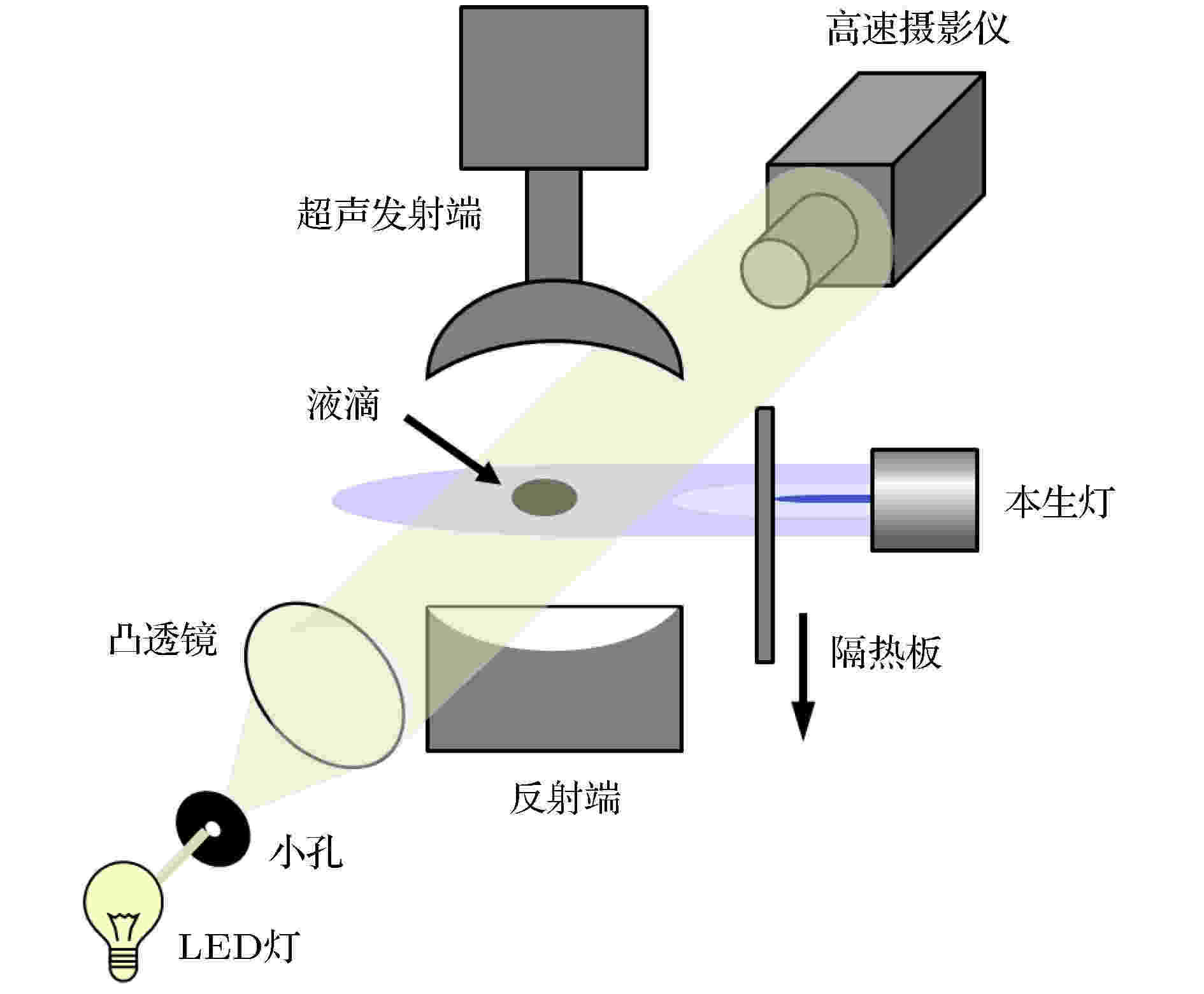
2020, 69 (18): 184702.
doi:10.7498/aps.69.20200562
Abstract +
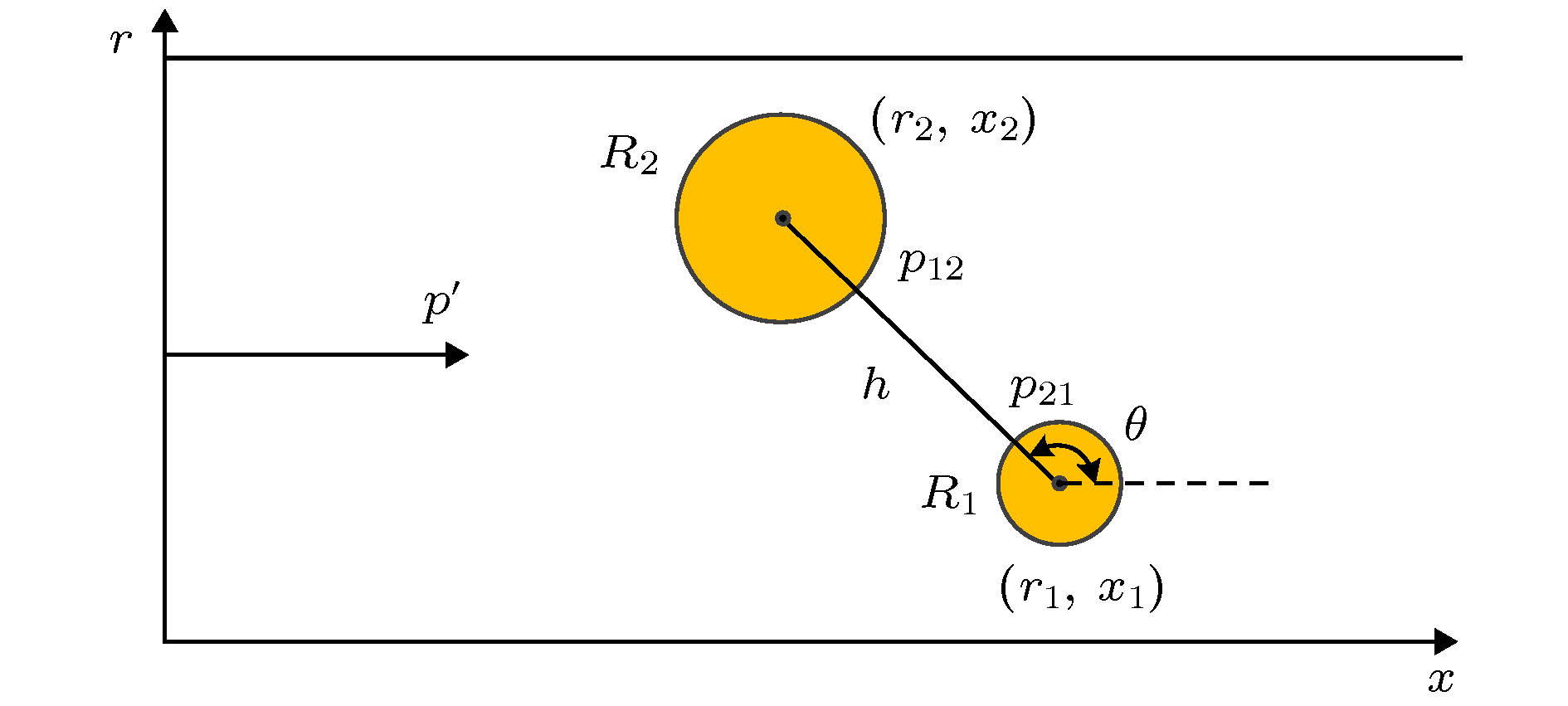
2020, 69 (18): 184703.
doi:10.7498/aps.69.20200546
Abstract +
Acoustically-excited bubble dynamics is the foundation of pipeline bubble detection based on acoustic technology. Due to the existence of multiple bubbles in pipeline flow, the Bjerknes forces among arbitrary bubbles under acoustic excitation may enforce bubble-bubble interaction and then change the features of bubble dynamics. Based on traditional free bubble’s Rayleigh-Plesset (R-P) model, this paper tries to establish bubble-bubble interaction model in consideration of the second Bjerknes force and bubble distribution in the pipeline axial direction. Meanwhile, the influence of finite wave speed in compressible fluid is considered. The proposed model is numerically calculated by the fourth-order Runge-Kutta method. Firstly, the differences in bubble feature between the free bubble’s R-P model and bubble-bubble interaction model are compared under excitation with different frequencies and amplitudes. Results show that the differences in bubble dynamics are minor when the bubble’s distance is large enough. When the bubble’s distance is fixed, the differences are significant on condition that the frequency of acoustic excitation is nearly the resonant frequency of bubbles. Secondly, through establishing compressible model and incompressible fluid model, we compare the differences between the two models. Numerical calculations show that the second Bjerknes force under the compressible assumption acts as an external force and forces the bubble to vibrate. On the other hand, the second Bjerknes force under the incompressible assumption changes the dynamics of bubble-bubble interaction as well as the resonant features. Finally, we study the effect of bubble-bubble distance and bubble’s axial position on bubble vibration characteristics. The bubble-bubble distance affects the second Bjerknes force and may lead the bubbles to vibrate nonlinearly. The bubble’s axial position changes the phase of external acoustic force and leads to the difference in initial vibration feature. When this difference is coupled with the second Bjerknes force, the bubble-bubble interaction may be changed even into nonlinear vibration, leading the bubble’s oscillation spectrum to differ from linear vibrations significantly. These results demonstrate that the resonant state of a small bubble may be converted into nonlinear vibration state if the second Bjerknes force is present. On the other hand, the resonant state of a large bubble can keep linear vibration when the second Bjerknes force is not obvious.
PHYSICS OF GASES, PLASMAS, AND ELECTRIC DISCHARGES
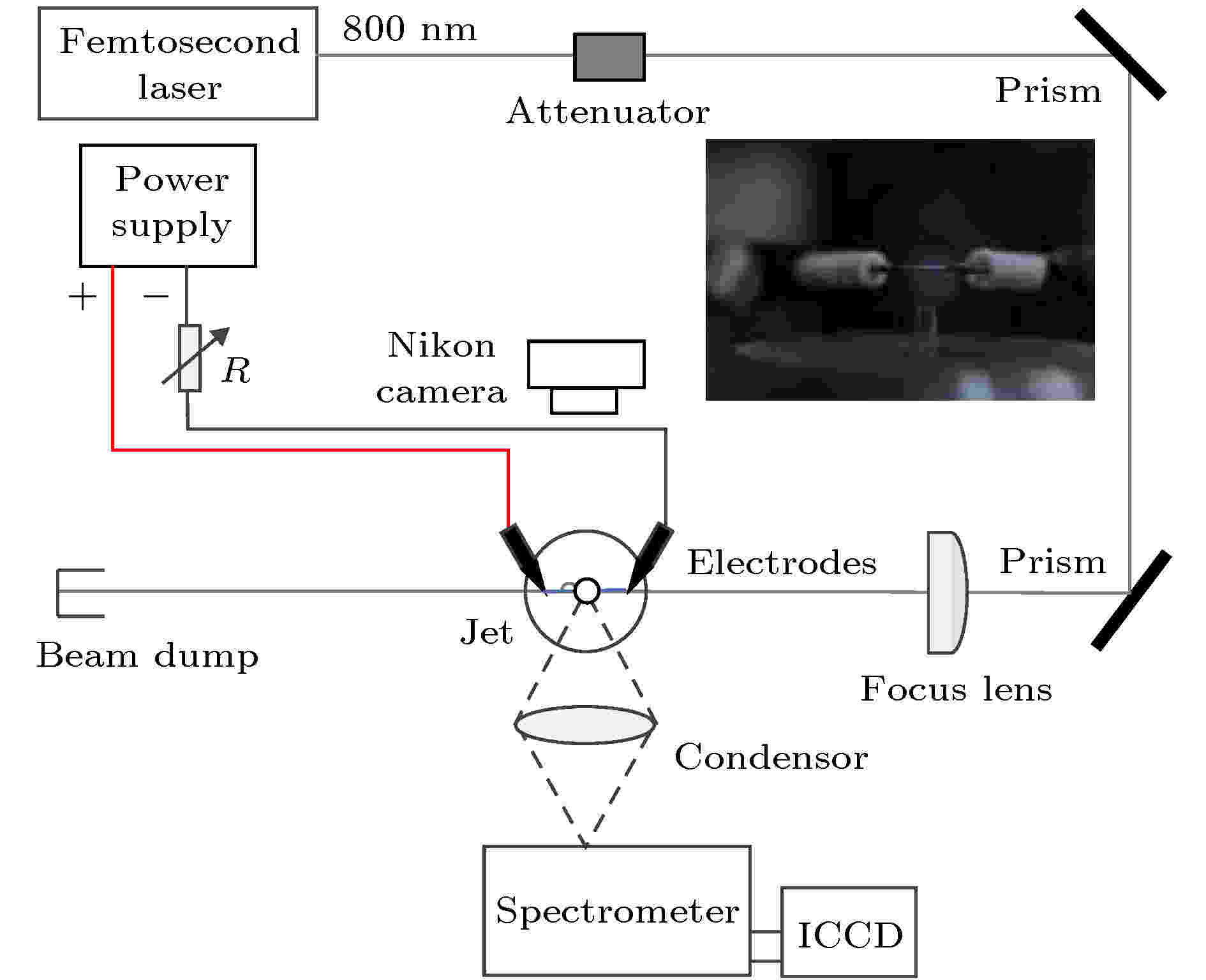
2020, 69 (18): 185201.
doi:10.7498/aps.69.20200636
Abstract +
SF6is widely used in gas insulated switchgear due to its excellent insulating and arcing performance. SF6arc plasma has been extensively studied, but time-resolved spectral characteristics of SF6arc plasma have not been reported. In this paper, the optical filament generated from focused femtosecond laser is used to guide the high-voltage discharge for generating SF6plasma in SF6environment. The SF6plasma spectrum is obtained in a wavelength range of 300–820 nm, and the identification and attribution of the spectral lines are investigated. The S and F lines are mainly in the 300–550 nm band and 600–800 nm band, respectively. The analysis shows that the S and F atoms are mainly directly or indirectly generated by the collision between SF6and high-energy electrons during the SF6decomposition caused by discharge. The S ions are generated by the collision of S atoms with high-energy electrons. The time-resolved spectrum of the SF6plasma superimposed by the continuous spectrum and the line spectrum is given, and its intensity increases and then decreases. The continuous spectrum is mainly generated by the combined effect of bremsstrahlung and recombination radiation. The recombination radiation is mainly generated by the collision of electron with ions and the recombination between molecular and atoms after SF6decomposition. The fluorescence lifetime of S ion at 409.91 nm is 57 ns, and the fluorescence lifetime of F atom at 685.60 nm is 341 ns. The evolution law of electron temperature and density with time are given. The electron temperature reaches 2047 K in the early stage of plasma formation. After that, the electron temperature quickly falls to about 1600 K within 300 ns due to the rapid expansion of the plasma and the increase in energy loss during electron movement. At the beginning of discharge, a large number of electrons are generated due to the rapid decomposition of SF6, and the electron density is highest (
$ 10.1 \times {10^{17}}\;{\rm{c}}{{\rm{m}}^{ - {\rm{3}}}}$
). After that, the electron density drops rapidly within 200 ns because the recombination between electrons and ions decreases with delay time. Finally, it is proved that the SF6plasma is in local thermal equilibrium based on the Mc Whirter criterion. The results are of great significance for studying the decomposition mechanism of SF6and the on-line monitoring technique of high-voltage equipment.
CONDENSED MATTER: STRUCTURAL, MECHANICAL, AND THERMAL PROPERTIES
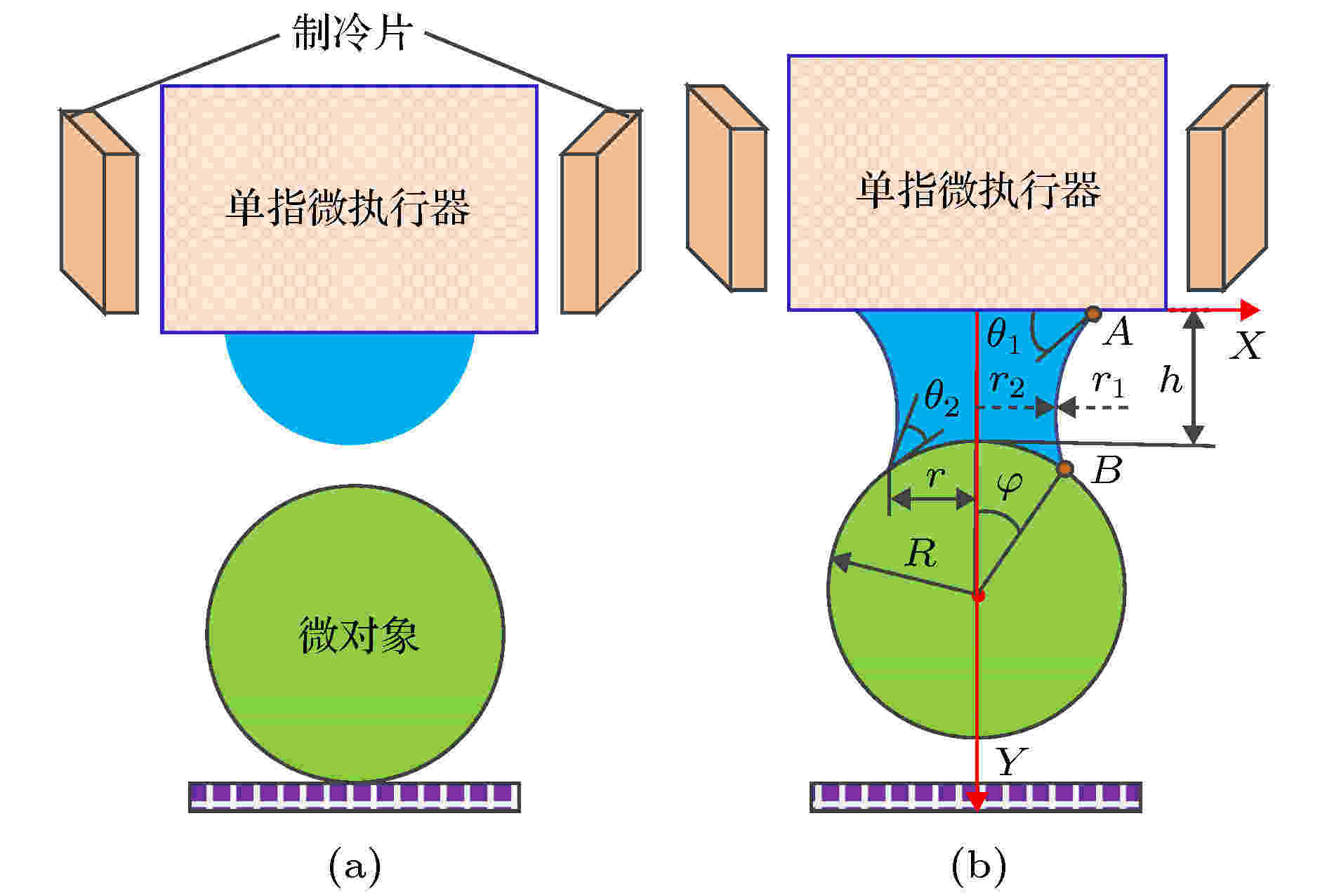
2020, 69 (18): 186801.
doi:10.7498/aps.69.20200463
Abstract +
Liquid droplet is a prerequisite for micro-robot based on liquid medium. The investigation of the migration characteristics of condensed droplets on the end surface of a single-finger microgripper is of significance for obtaining stable droplets. The principle of flexible operation for micro-components using droplet condensation is analyzed first. The liquid bridge force acting on a microsphere is derived. A growth model of condensed droplet on the tip of a single-finger microgripper is established, including single-droplet growth, droplet coalesce, droplet movement, and pining effect. Condensation process on the tip of single-finger microgripper with a diameter of 130-400 μm is observed experimentally. Small droplets are formed by directly growing with a big growth rate in the initial stage, then the droplet growth is determined by droplet coalesce. The experimental results show that a single droplet is formed on the end surface after direct growth and droplets coalesce. The maximum droplet volume of 5.5 nL appears on the tip of a single-finger actuator with a diameter of 400 μm under the conditions of surface temperature of –5 °C, room temperature of 24 °C and humidity of 37%. The stability of the formed droplets is dominated by temperature gradients and edge effects during growth process. The distribution of condensed droplets is asymmetric while the microgripper is placed on a cooling surface with temperature gradient. A big growth rate is shown in a low temperature range. A single asymmetric droplet with an offset of 13 μm with respect to the axis of the actuator is formed, which is caused by the temperature gradient. A stable contact angle of 112° is obtained on the end surface of a single-finger microgripper with a diameter of 137 μm because of edge effect using the ambient temperature of 24 °C and humidity of 42%. Condensed droplets located on the end surface of hydrophobic microgripper are more stable than the untreated microgripper. Compared with the droplet formation (0.3 nL) on an untreated microgripper with a diameter of 150 μm, a lager stable droplet of 0.4 nL is obtained on the end face of a small microgripper with a diameter of 130 μm because of the hydrophobic action. The validity of theoretical analysis is verified by experimental results. The experimental investigation of the migration characteristics of condensed droplets on the end surface of a single-finger microgripper shows that the droplet shape can be changed by adjusting the temperature gradient and hydrophilic/hydrophobic performance, which plays an important role in achieving a stable droplet on the end surface.
CONDENSED MATTER: ELECTRONIC STRUCTURE, ELECTRICAL, MAGNETIC, AND OPTICAL PROPERTIES
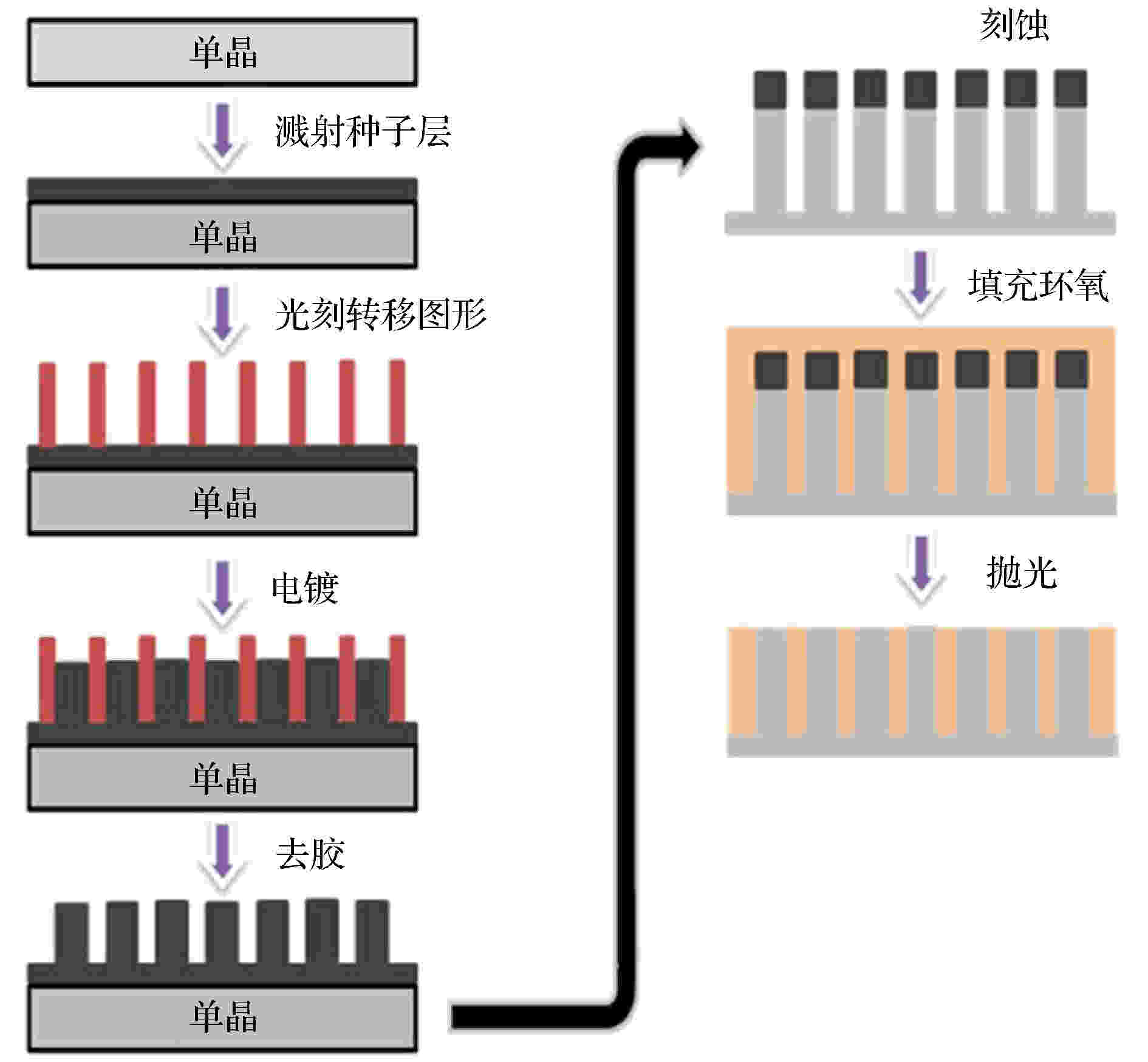
2020, 69 (18): 187701.
doi:10.7498/aps.69.20200544
Abstract +
Relaxor ferroelectric single crystal piezoelectric materials have become the core components of new piezoelectric devices such as ultrasonic transducers used in high-end medical ultrasound diagnostic and therapeutic equipment. High-element density array technology and micro-electro-mechanical systems have developed rapidly. For the new generation of 20–80 MHz medical high-frequency ultrasound transducers, the thickness of high-frequency piezoelectric composite material is usually 20–60 μm, and the width of each piezoelectric column is about 5–15 μm. However, the kerf of traditional cutting-and-filling method is too wide, and it is difficult to reduce the size of the array element, which is not conducive to the density of the array element and the demand for higher frequency applications with higher resolution. In this work, a micromechanical fabrication method based on deep reactive ion etching is used to reduce the slit width and increase the array density. We study the fabrication technology of novel and high-performance relaxor ferroelectric single crystal Mn doped Pb(In1/2Nb1/2)O3-Pb(Mg1/3Nb2/3)O3-PbTiO3(Mn-PIMNT) micro scale piezoelectric array. The influence of the parameters of lithography and deep reactive ion etching on the morphology of piezoelectric array are studied. We obtain the formation mechanisms of different kerfs, different shapes of piezoelectric array element and the relationship among etching rate of Mn-PIMNT single crystal with antenna power, bias power and etching gas ratio. Finally, the size of piezoelectric array element is less than 10 μm, the etching depth is more than 20 μm, the kerf width is less than 5 μm, the angle is controllable, and the maximum is more than 87°. The ferroelectric domain structure and the regulation of electric field effect of micro scale piezoelectric elements are studied by means of piezoelectric force microscope. The variation rules of piezoelectric properties and micro scale are obtained. This method can effectively bypass the shortcomings of the wide kerf and the destruction of the crystal orientation by the traditional cutting-and-filling method. It provides a new preparation technology for the development of high-frequency piezoelectric composites, high-density ultrasonic transducer arrays and new piezoelectric micro mechanical systems. This project presents the guidance and reference for the new micromachining technology of ferroelectric materials, and also lays the foundation for the high-frequency piezoelectric composite and high-frequency ultrasonic transducer.
INTERDISCIPLINARY PHYSICS AND RELATED AREAS OF SCIENCE AND TECHNOLOGY
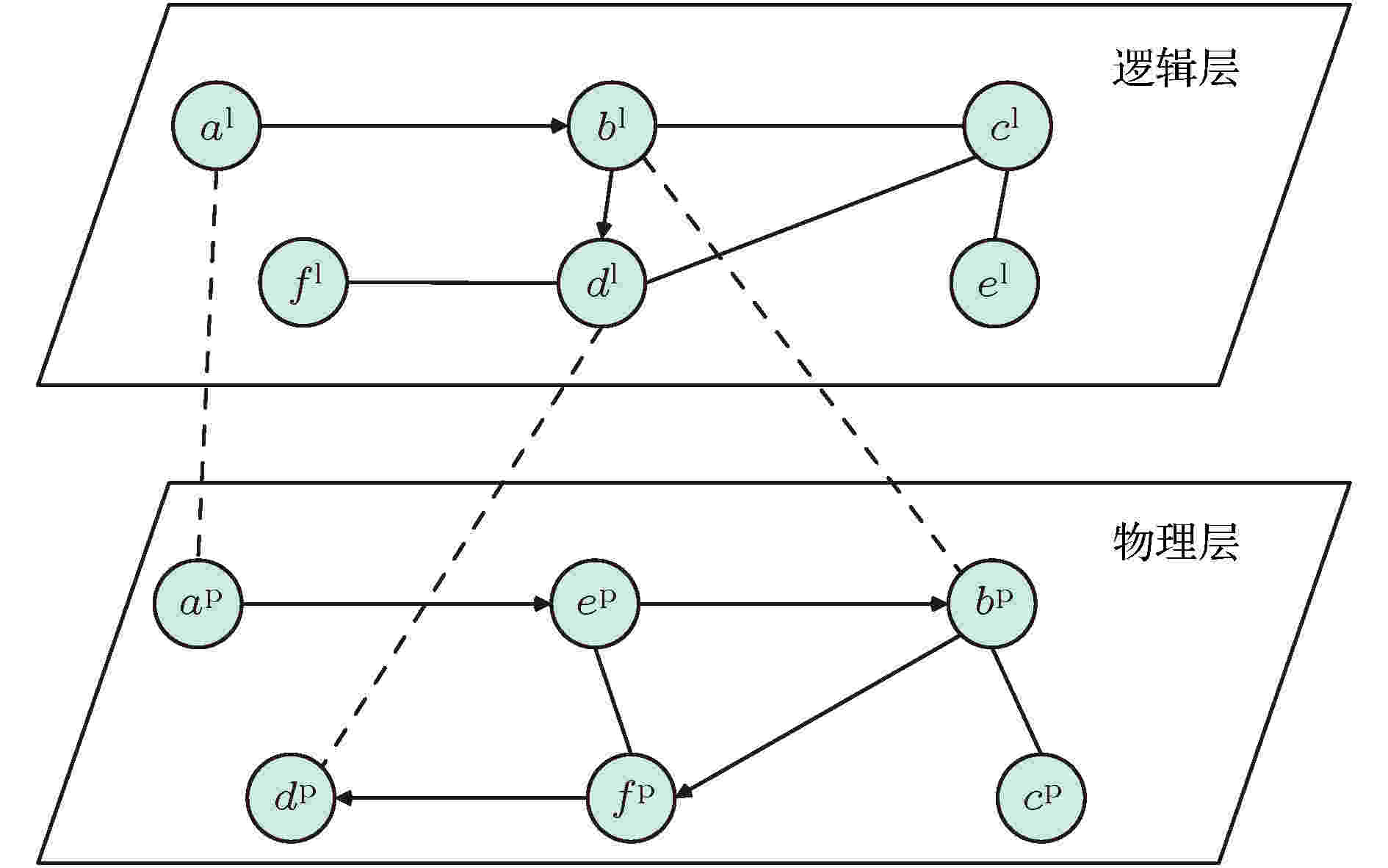
2020, 69 (18): 188901.
doi:10.7498/aps.69.20200181
Abstract +
The two-layer network model offers us a new viewpoint to observe the traffic dynamics of multilayer network systems. An efficient coupling mechanism is of great importance for alleviating the traffic congestion on two-layer networks. In order to reduce the network congestion and improve network transmission performance, the coupling mechanism between two layers of network and three coupling methods, which are random coupling, disassortative coupling and assortative coupling, are studied based on degree correlation. The packet transmission process is analyzed with both the shortest path routing strategy and degree-based weight routing strategy. The influences of the coupling mode and its corresponding routing strategy on the traffic capacity of the two-layer network are studied. In this paper, two scale-free networks are used to construct the two-layer network for simulation experiments. The network scale is in a range from 200 to 2400 with the value of average degree being 8. We focus on the traffic dynamics of two-layer network, and analyze the relationship between the traffic capacity and the three coupling modes, which are random coupling, disassortative coupling and assortative coupling, under the constraints of the shortest path routing strategy and the weight-based routing strategy. According to the characteristics of the coupling connection between the two layers of network, the best coupling method which is suitable for a certain routing strategy should be investigated. The suitable coupling connection between the two layers can effectively increase the traffic capacity. Both numerical result and analytical result show that the packet generation rate, average transmission time, and average throughput can be obviously improved under the shortest path routing strategy with the disassortative coupling method. When the degree-based static weight routing strategy is used, the traffic performance parameters such as packet generation rate, average transmission time, and average throughput can reach the optimal values with the assortative coupling method. It makes the traffic flow uniform that the routing strategy is chosen with the most suitable coupling method on the two-layer network, and the network traffic capacity may be effectively enhanced. More generally, the results indicate that the coupling modes can give rise to traffic behavior that relies subtly on the routing strategy on the two-layer network. Our work may shed some light on the design and optimization of some real traffic or communication networks.
GEOPHYSICS, ASTRONOMY, AND ASTROPHYSICS
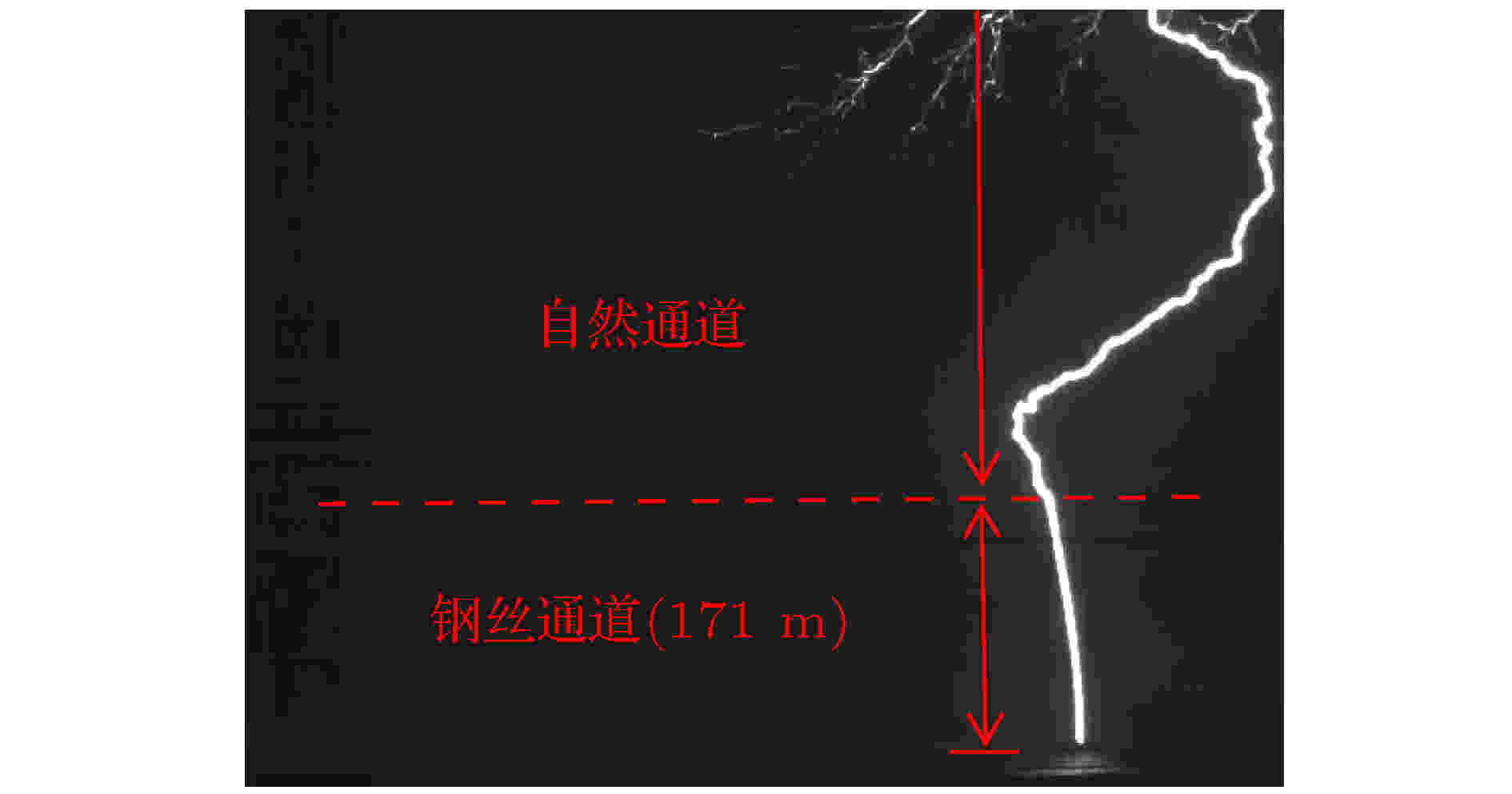
2020, 69 (18): 189201.
doi:10.7498/aps.69.20200374
Abstract +
Characteristics of a triggered bipolar lightning flash obtained in the Shandong triggering lightning experiment (SHATLE) are analyzed based on simultaneous observation results of lightning very high frequency (VHF) interferometer map, channel-base current, fast electric field change and high-speed optical images. The flash lasts about 315 ms with only the initial continuous current (ICC). As the polarity of charges transferred to the ground varies from negative to positive and then to negative, the ICC can be mainly divided into three stages including the first negative ICC stage, positive ICC stage, and second negative ICC stage, respectively, for 152.755 ms, 87.225 ms and 75.02 ms. Charges transferred to the ground during the three stages are about –40.0 C, +13.3 C and –1.0 C, respectively, with the peak current of about –3.8 kA, 1.6 kA and –2.25 kA. According to the VHF interferometer map, during the first negative ICC stage, the upward positive leader (UPL) initiated from the top of the wire as negative charges starts to be transferred to the ground. The UPL develops at a two-dimensional (2D) speed of 3.7 × 104m/s into the cloud and multiple positive branches develop in the form of small-scale and dense recoil leaders, keeping the increase of negative charge transferred to the ground. Then a negative leader (NL) initiates on a previously ionized positive branch channel and develops into the virgin air horizontally as a floating channel at a 2D propagation speed of 1.59 × 105m/s. About 28.816 ms later after the NL develops, a negative pulse is detected in the fast electric field change, caused by a negative polarity breakdown discharge from the grounding trunk channel to the floating channel which is observed for the first time. Then about 39 μs later, the first polarity of the channel-base current changes from negative to positive, and rapidly reaches a positive peak in 1.75 ms. Subsequently, with the positive ICC decreasing, the negative leader gradually terminates about 65.85 ms after the first polarity reversal, and then 21.38 ms later the channel-base current slowly changes to the recognizable negative polarity as the second polarity reversal. A recoil leader generating in a previously ionized positive branch channel connects to the trunk channel, resulting in the initial continuous current pulse (ICCP) during the second negative ICC stage. Then several negative recoil leaders occur, tracing back to the previous positive channels without obvious current changes until the flash ends. Based on the analysis, the positive branch channel persistently transfers negative charge to the ground in the whole discharge process by the positive breakdown on the tip or the negative recoil leaders retrograding along the previous positive channels. The trunk channel is connected to the floating channel through negative breakdown discharges, linking at the positive charge accumulation area at the tail end of the negative leader or the positive polar end of a bidirectional leader towards the trunk channel, if the negative leader develops as a bidirectional leader later. Then, the net charge transferred to the ground is dominantly positive and the reversal of first channel current polarity occurs. With the negative leader disappearing, the supply of positive charge ceases, so the current polarity reverses again (the second reversal). Connection of the negative leader to the grounding trunk channel and continuous development of the positive leader are inferred to play an important role in reversing the two current polarities. In this case, the negative leader developing in virgin air might be initiated transversely in an ionized positive channel or from the end of a decayed positive leader branch of the ionized positive channel which is small and undistinguishable from the VHF interferometer map.
















